- 1 Introduction
- 2 Description
- 4 Advantages
- 5.1 Pressure Supply Function
- 5.2 Level Control Function
- 6.1 Location of electrical/electronic components
- 6.2 Location of pneumatic/hydraulic components
- 6.3 Compressor and cable related parts
- 6.4 Compressor Relay (K40/7kO)
- 6.5 Compressor Relay Fuse (K40/7f32)
- 6.6.1 Design of Compressor Unit
- 6.6.2 Function of AIRmatic Compressor Unit
- 6.6.3 Air Filter
- 6.6.4 Air Dryer
- 6.6.5 Electrical connectors
- 6.7.1 Parts
- 6.7.2 Design of Level Control Valve Unit (Y36/6)
- 6.7.3 Function of Level Control Valve Unit
- 6.8.1 Function of Pressure Sensor (B7)
- 6.8.2 Parts
- 6.9 Level Sensor (B22/3, B22/8, B22/9)
- 6.10 AIRmatic Central Reservoir (42)
- 6.11 Comfort and sport switch (N72/1s3)
- 6.12 Level Control Switch (N72/1s2)
- 6.13 AIRmatic with ADS Control Module (N51)
- 6.14.1.1 Design of Front Axle Spring Strut (40)
- 6.14.2 Operation of Air Spring Struts (40, 41)
- 6.14.3 Function of Air Spring Struts (40, 41)
- 6.14.4 Parts (Spring Strut)
- 6.15.1.1 Design of Damping Valve Unit (Y51, Y52, Y53, Y54)
- 6.15.1.2 Components of Damping Valve Unit (Y51, Y52, Y53, Y54)
- 6.15.2 Force Settings
- 6.16 Multifunction display (A1p13)
- 7.1 "AIRMATIC VISIT WORKSHOP!" message on the instrument cluster
- 7.2 "AIRMATIC STOP, CAR TOO LOW!" message on the instrument cluster
- 7.3.1 Air Bag/Bladder Leaking
- 7.3.2 Height Measuring Technique
- 7.3.3 Top Seals Leaking
- 7.3.4 Repair Options for AIRmatic Air Suspension Strut
- 7.3.5 AIRmatic Compressor Unit Failure
- 7.3.6 Pressure Lines Leaking
- 7.3.7 Level Control Valve Unit Leaking
- 7.3.8 Central Reservoir Leaking
- 7.3.9 Level Sensor Faulty
- 7.4.1 Level Control Valve Unit Leaking
- 7.4.2 Compressor Unit Release Valve Stuck
- 7.4.3 Level Sensor Failure
- 7.5 Protective Boot/Bellows Failure
- 7.6 Upper Mount Rubber Bush Failure
- 8.1 Original M-B limp-home buffers
- 10.1 Testing strut for leaks
- 10.2 Inspecting AIRmatic Level Control Valve Unit (Y36/6) for leaks
- 10.3 Leak Testing Using STAR Diagnosis System (SDS) or Diagnosis Assistance System (DAS)
- 10.4 Replacing Compressor Unit
- 10.5 Compressor Unit Repair
- 10.6.1 O-ring repair kit
- 10.7 Line Repair
- 10.8 Leaking Front Strut Air Spring - Repair Options
- 10.9.1 Tutorials
- 10.10.1 Tutorials
- 10.11.1 Dismantling Front Air Spring
- 10.11.2 Reassembly Front Air Suspension Strut (40)
- 10.11.3 Tools Required for Replacing Air Spring in Front Air Suspension Strut (40)
- 10.11.4 Tutorials
- 10.12 Remove/install front axle level sensors
- 10.13 Remove/install rear axle level sensor
- 10.14 Airmatic Adjusting Levels Using STAR Diagnosis System (SDS) or Diagnosis Assistance System (DAS)

Introduction
All W220 vehicles come with Airmatic pneumatic suspension system, unless vehicle has option code 487 - ABC SUSPENSION (ACTIVE BODY CONTROL) in which case the vehicle is equipped with Active Body Control (ABC) hydraulic suspension system with additional computer control. ABC system provides greater roll control and eliminates any "nosedive" even with heavy braking (not that there is much of either with Airmatic). Both suspension systems are responsible for the superb ride and handling of the W220 and being complex systems will require maintenance.
Airmatic systems on earlier cars tended to fail more often than on the '03 and later - the '04s and on are less problematic. However, there is no such thing a "bulletproof" pneumatic suspension system. Seals and pumps will wear, and struts will have to be replaced. You'd have to do the same thing with standard shocks, too - but Airmatic will be more expensive. The best protection is to become familiar with the early signs of Airmatic problems, and fix them right away. Letting them go runs the cost up.
They are not especially problematic, but like any complex system, they break - and any luxury car is expensive to repair. Keep in mind that if the garage you use does not have STAR Diagnostics and can not interpret the values both in sensor voltage and other tests, then don't waste your time and money. Find someone who can. DIY is possible but preferably requires use of STAR Diagnostics with some prior experience and always lots of patience.
One common failure point which was initially subject to inspection and free replacement, was the high-pressure line from the pump to the valve body.
Another common weakness in the pre '03-ish W220's compared to those from a few years later, is the seals at the tops of the front suspension struts. The older design can leak air over time. The newer models and ones with new replacement parts do not leak. Cars that were under warranty could have these seals replaced with that coverage.
Other issues are discussed below.
The EMERGENCY Procedure, or what to do if your car is sitting on the ground, is shown below.
Some of the air suspension components covered in this page are also used in W211, W216, W219, W221, W240 and W639 MB chassis vehicles.
Description
The W220 AIRmatic system is a fully supporting air suspension system which provides both static and dynamic support by means of four air struts located at the wheels. Each strut has an air spring containing an air bag (bladder) and a dampener built-in to the one unit. The struts get air via a valve distribution unit from an air compressor located behind the front bumper close to the front right wheel well. On the opposite side is the central reservoir which stores air pressure for use when the pump is not running. The valve unit is connected to a computer which monitors the air pressure, the vehicle weight, the vehicle height requirement and vehicle stance (angle) and then sets the ride height accordingly.
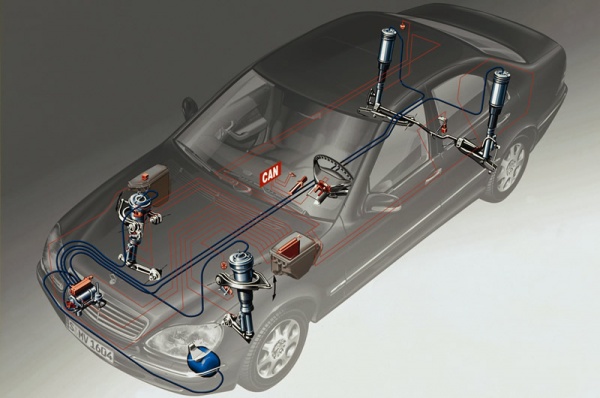
- Level control both manual and speed sensitive.
- When the vehicle is stationary the level is readjusted if there is a difference of more than +/- 10mm after a door or the trunk lid is opened.
- While driving the level is readjusted if there is a difference of more than +/- 20mm. The level is adjusted to +/- 10 mm every 15 minutes.
- Active Damping System (ADS) which changes the damping forces according to the road conditions and the driver's driving style. The road conditions are determined by vertical acceleration sensors in the body of the vehicle. The horizontal acceleration is determined by measuring the vehicle speed and turn angle.
Higher level of driving safety and ride comfort due to:
- Adapting damping to road conditions and driving style.
- Low location of centre of gravity as vehicle lowers above 70KPH.
- Low aerodynamic drag and fuel consumption as vehicle lowers above 70KPH.
- Less tendency for vehicle to lift at speed.
Individual adaptation due to:
- Raising vehicle level for poor road surfaces and when negotiating driveways.
- Two possible damping levels for comfort or sport driving styles in vehicles produced up to 08/99.
- Three possible damping levels for comfort, sport or extreme sport driving styles in vehicles produced after 09/99.
Driver information due to:
- Vehicle level displayed by indicator lamps and switches.
- Warning messages in multi-function display if vehicle is too low.
The functions of the AIRmatic with Adaptive Damping System (ADS) control module are divided as follows:
Signal conditioning
Function logic component
Safety circuit
The following input signals are processed by the function logic component and used for calculations or to provide information:
- Signal from body acceleration sensors
- Wheel speed signal
- Speed status signal
- Signal from steering angle sensor
- Outside temperature, outside air pressure signal
- Reservoir pressure signal
- Vehicle speed signal
- Vehicle level signal
- Level signal from left front axle, right front axle
- Rear axle level signal
- Pressure signal
- Signal from level sensors
- Signal from stop lamp switch
- Signal from comfort and sport switch
- Signal from level control switch
- Signal from door contact switch, trunk, remote control
The conditioned input signals are processed in the logic component and converted into output signals.
- The vertical acceleration of the vehicle is calculated using the signals from the body acceleration sensors.
- Using the wheel speed signal, the ESP control module calculates
- Vehicle speed
- Longitudinal acceleration
- Vehicle status. A distinction is made between a moving and a stationary vehicle. Incorrect wheel speed signals are also detected.
- The lateral acceleration of the vehicle is calculated using the steering angle sensor signal and the wheel speed signal.
- Both front axle level sensors each supply 2 signals. The sensors detect and transfer the distance between the wheel center and the body at both the left and right-hand side of the vehicle.
- The rear axle level sensor supplies 2 signals. The sensor detects and transfers the distance between the wheel center and the body (average calculated from left and right wheel).
- When the driver presses the brake pedal, a signal is received by the ADS logic component and the damping at all wheels is set to "hard". The pitch motion of the vehicle when braking can therefore be reduced.
- The comfort and sport switch signal informs the system about the selection made by the driver between one comfort-oriented and 2 sporty damping maps. The "comfort" setting maintains the damping within the comfortable range as far as the driving style and road conditions will allow. The "Sport 1" setting makes the damping somewhat "harder". The "Sport 2" setting immediately sets the damping force to "hard". The driver's preferred settings are stored until changed by the driver (even with Ignition OFF).
- Normal level
- Raised level
- The control module uses the vertical body acceleration, longitudinal and lateral acceleration of the vehicle and the ground speed to determine the optimum level of damping. 4 different damping forces can be set at each wheel by controlling the damping valves located at each wheel. Phased in as of 09/00, the damping is set to the Sport 1 damping level if the vehicle speed is >160 km/h.
- The control module uses the setting of the level adjustment switch selected by the driver and the ground speed of the vehicle to control the appropriate level control valves and to set the correct vehicle level according to the vehicle load.
- The AIRmatic system is equipped with a pressure reservoir to keep the level control time as short as possible (e.g. after loading). The reservoir pressure is used only when required in order to prevent filling the reservoir too often. This happens, for example if the vehicle level falls below a critical level when loading the vehicle or if the driver has set the vehicle level to "raised level". Pressure from the reservoir is also used when the vehicle is stationary to minimize noise. With normal control when the vehicle is moving, the spring struts are supplied directly by the air compressor.
- The main control parameters are the pressure in the main reservoir, the outside air pressure and the vehicle speed.
- The compressor is controlled via a relay. Since the compressor is not designed for continuous operation, the absolute running time and cooling phase are monitored to avoid overloading the compressor.
- Wake-up function
A parked vehicle is "woken up" before the engine is started. That is to say, the AIRmatic with ADS control module receives signals from the door contact switches, the trunk switch and infrared remote control indicating that the driver may soon start the engine and drive the vehicle. The current vehicle level is checked immediately and corrected if required. The vehicle level at the front axle is considered to be critical, for instance, if the full wheel angle can no longer be guaranteed. In this case a message appears on the multifunction display in the instrument cluster to warn the driver: "Stop car too low". If the control module is woken (for example by opening one of the doors), there follows a period of spare time before the driver actually starts the engine during which the vehicle level is corrected. This reduces the waiting time required to correct the vehicle level and the vehicle is ready for driving more promptly. Pressure in the main reservoir is used to raise the stationary vehicle. The compressor is only used if the pressure reservoir is empty. It must be ensured that the battery voltage is sufficient to then start the engine.
- Locking function
If the control module detects that all wheels are unloaded when the vehicle is stationary, the valves of the spring struts are closed. The vehicle therefore remains at the current level. This is essential, for example, when changing a wheel or during repair work (lifting platform).
The AIRmatic with ADS control module monitors all the important components of the system after they are switched on and during operation. The safety circuit detects faulty signals from sensors, faults in the control module and in the electric line system. If a fault is detected, the system is switched off and a message is displayed on the multifunction display in the instrument cluster to warn the driver. The damper valves for ADS are no longer controlled and remain set to the "hard" damping level (driving safety level). In addition, a fault code is stored in the control module. The level control is partially switched off depending on the fault that occurred. The system always strives to maintain the selected vehicle level. Moreover, the safety circuit continuously monitors the battery voltage. If the voltage falls below 10.5 V or exceeds 17.5 V, the system is switched off until the voltage returns to the specified range.
Pressure Supply Function
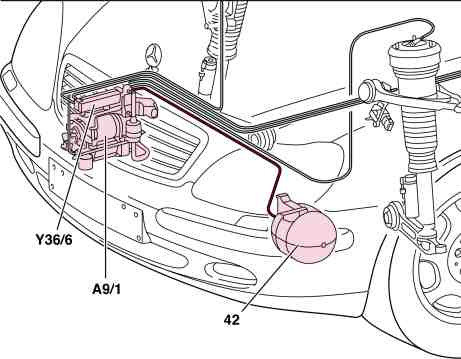
- 42 - AIRmatic Central Reservoir
- A9/1 - AIRmatic Compressor Unit
- Y36/6 - Level Control Valve Unit
In normal driving mode, AIRmatic works with a pressure of between 6 and 10 bar (600 and 1,000 KPa or 87 and 145 psi) depending on the load. An electrical compressor is used to supply pressure. This is installed in the AIRmatic Compressor Unit (A9/1).
In addition the system has an AIRmatic Central Reservoir (42) which stores the compressed-air. The AIRmatic Central Reservoir (42) pressure is between 13 and 16 bar (1,300 and 1,600 KPa or 189 and 232 psi) (at sea level).
The AIRmatic system is either supplied with pressure via the AIRmatic Central Reservoir (42) or via the AIRmatic Compressor Unit (A9/1).
Level Control Function
The AIRmatic at the front and rear axle is a fully supporting suspension system. It keeps the vehicle level constant when the engine is running irrespective of the load. At the same time air from the air compressor is delivered to the spring struts via the valve unit until the vehicle level has been adjusted. The vehicle level at the front axle is recorded by two level sensors at the front axle and conveyed to the AIRmatic with ADS control module. The level at the individual spring struts is controlled by four level valves in the valve unit and a pressure relief valve on the AIRmatic compressor unit.
An AIRmatic central reservoir for compressed air also enables the vehicle level to be controlled when the engine is not running. In addition the adjustment of the vehicle level is decoupled from the air compressor.
Shut-off position function
If the unloading of all the wheels when the vehicle is stationary is recognized by the control module, the spring strut valves are closed. The vehicle therefore remains at the current level. This is required when changing a wheel or for repair work (hoist) for example.
Normal function (engine running)
When the vehicle is stationary the level is readjusted if there is a difference of more than +/- 10 mm after a door or the trunk lid is opened.
While driving the level is readjusted if there is a difference of more than +/- 20 mm. The level is adjusted to +/- 10 mm every 15 minutes.
Depending on the situation, pressure can be generated by the compressor or the pressure supply of the AIRmatic central reservoir can be used to raise the vehicle. When the vehicle is stationary the pressure from the reservoir is used for noise reasons. Pressure can also be supplied from the compressor and AIRmatic central reservoir at the same time when there is a particularly high pressure demand.
The lowering of the vehicle level is recognized by the control module from the level sensors when loading the vehicle. By actuating solenoid valves air is delivered to the spring struts of the particular front wheel or rear axle until the vehicle has reached its specified value. In addition the pressure relief valve is opened to actuate the respective wheel valve when unloading the vehicle.
Wake-up function (operating period approx. 1 minute)
The AIRmatic with ADS control module is "woken up" using the remote control, door contact switches or trunk illumination switch in order to check the current vehicle level for critical conditions (level too low) and if necessary to raise the vehicle or lower it when unloading. If the vehicle level is lowered by more than 30 mm, it is raised to the normal level by the reservoir (only with a reservoir pressure > 11 bar). At a vehicle level of < -65 mm and even at a reservoir pressure of <11 bar it is raised out of the "critical range" by the compressor to -63 mm (condition: battery voltage > 12.4 V).
If the vehicle level is raised by more than 10 mm when unloading, it is lowered to the normal level by relieving the pressure.
The vehicle cannot be raised by the level control switch.
Function in vehicle condition "Ignition ON"
The same function as for the wake-up function, but without time limit.
Run-on function (operating period approx. 1 minute)
After "ignition OFF" the control module performs changes in the level in order to be able to readjust the vehicle level (raise or lower) during any loading or unloading operations. (The same function as for the wake-up function).
Location of electrical/electronic components
- A9/1 - AIRmatic compressor unit
- A1p13 - Multifunction display
- B7 - AIRmatic pressure sensor
- B22/3 - Rear axle level sensor
- B22/8 - Left front level sensor
- B22/9 - Right front level sensor
- B24/3 - Left front body acceleration sensor
- B24/4 - Right front body acceleration sensor
- B24/6 - Right rear body acceleration sensor
- K40/7 - Right front fuse and relay module
- kO - AIRmatic compressor relay
- N49 - Steering angle sensor
- N51 - AIRmatic with ADS control module
- N72/1s2 - Level control switch
- N72/1s3 - Comfort and sport switch
- S9/1 - Stop lamp switch
- X11/4 - Data link connector
- Y36/6 - Level control valve unit
- Y51 - Left front axle damping valve unit
- Y52 - Right front axle damping valve unit
- Y53 - Left rear axle damping valve unit
- Y54 - Right rear axle damping valve unit
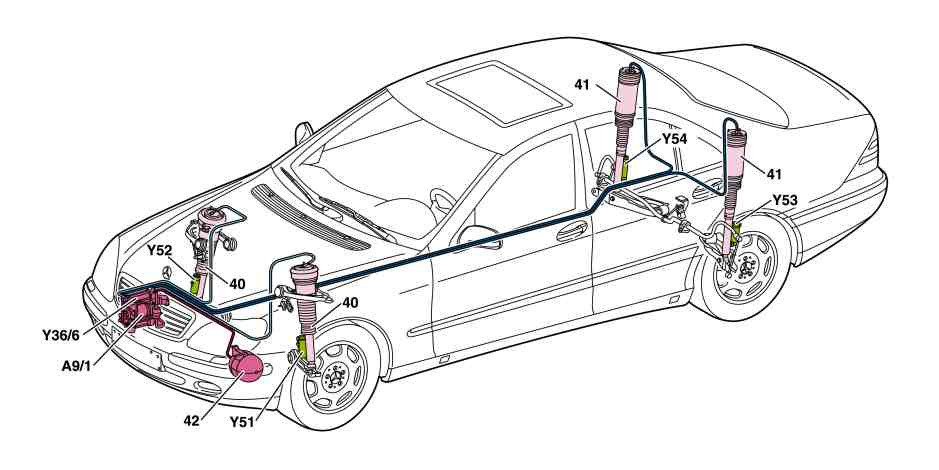
Location of pneumatic/hydraulic components
- 40 - Front spring strut
- 41 - Rear spring strut
- 42 - AIRmatic central reservoir
Compressor and cable related parts
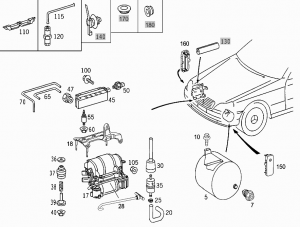
Compressor Relay (K40/7kO)
The Airmatic Compressor Relay (K40/7kO) is located in right fuse box , location 'O' (the first one next to the three 40 amp fuses). The relay starts and stops the Airmatic compressor. A faulty relay may cause the compressor to overheat thus damaging it. Hella relays have proven to be reliable. Part number 4RA 007 791-011 (A0025421319).
Compressor Relay Fuse (K40/7f32)
The compressor relay is powered by 40A fuse 32 located in the right fuse box.
Compressor Unit (A9/1)
The electric compressor generates the pressure required to lift the vehicle. The pressure relief valve integrated in the AIRmatic Compressor Unit (A9/1) is used to lower the vehicle.
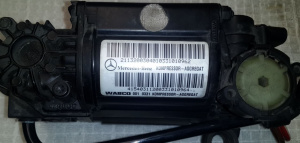
Design of Compressor Unit
The main part of the AIRmatic Compressor Unit (A9/1) is the compressor motor (m1). The other parts are the pressure relief valve, overpressure/residual pressure valve (b) and the air drier (c).
The air filter/cleaner (a) is located outside the compressor unit. It is connected to the unit by a hose. The air released when the vehicle is lowered is returned to the air filter/cleaner via the line (g) where it is then guided back out through the filter.
The compressor unit is mounted to a mounting plate (h).
The AIRmatic Level Control Valve Unit (Y36/6) is fixed at the top of the same mounting plate as the compressor unit and is connected to the compressor by a pressure line.
The valve unit is attached to the AIRmatic pressure sensor (B7).
Function of AIRmatic Compressor Unit
The air compressor is driven by the compressor motor (m1). The air to be compressed is sucked out of the vehicle longitudinal member through an air filter/cleaner and into the chamber underneath the piston. With the downward movement of the piston, the air passes through the inlet valve (e) in the piston crown into the clearance volume. With the upward movement of the piston, the inlet valve closes and the air is compressed. The compressed air is forced on via the outlet valve (d) into the air drier (c).
The silicate filling in the drier removes moisture from the air. From the air drier the dehumidified and compressed air then passes from the air drier into the central reservoir or directly to the suspension struts as required.
The pressure relief valve installed in the compressor unit (y1) is required for discharging air when lowering the vehicle. The discharged air is conducted through the air filter/cleaner back into the atmosphere. This also cleans the air filter/cleaner.
The air drier is maintenance free. The moisture is delivered back into the air when reducing the pressure.
It is difficult to get reliable information about the scheduled maintenance interval on the AIRmatic air filter. W220 community recommends to replace the air filter from time to time to prevent damage to the AIRmatic compressor. The filter can fill up with debris and salt which may block the air filter/cleaner. A new AIRmatic air filter costs around EUR 10, and it should not take more than 20 minutes to replace. For replacement method see the DIY compressor and filter replacement instructions below.
The air filter is protected with a protective boot. It may be hard to separate the filter from the rubber grommet housing. The housing may fail when trying to remove it, so make sure you have a replacement housing at hand. Put a dielectric grease on the inside of the housing prior to insertion of the replacement filter to support future removal.
Note : The arrow on the air filter shows the 'UP' direction and not the direction of air flow which is both ways.
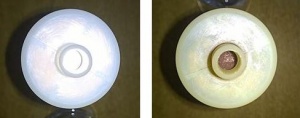
Silica gel is used as a desiccant in compressor unit. It works by a process called adsorption. The water in the air actually absorbs between the tiny passages as the air passes through them. The water molecules become trapped so that the air is dried out as it passes through the filter. This process is reversible. If the silica gel desiccant is heated it will release the trapped water. This process is called regenerating the desiccant. Once saturated with water, the gel can be regenerated by heating it to 120 °C (250 °F) for 1–2 hours. However, silica gel degrades after very few cycles if heated to 110°C or more. For maximum longevity dry it at just 80°C. It won't take much longer but will last longer and work just as well as a desiccant.
Once the silica gel gets saturated with water, the moisture will get in the system. Moisture will accelerate oxidation of aluminium parts (e.g., valve block).
Mercedes documentation claims that desiccant used for air drying is maintenance free. However, for the longevity of our vehicles, it is recommended to change the desiccant along with the air filter at some point. There are compressor unit repair kits sold on eBay that come with new dust filters and silica gel filling.
Note: The original silica gel drier beads are multi sized and a volume is calculated (gaps of air between the beads). This volume is impossible to calculate and replicate using aftermarket beads, therefore, it is recommended to dry and refit the original beads as exchanging them for new will lower the compressor flow rate (around 10-15%).
Electrical connectors
- Power supply - A1685453628 (from compressor relay K40/7kO)
- Pressure release valve - A1685452928 (from AIRmatic control module N51)
Level Control Valve Unit (Y36/6)
Located on the AIRmatic Compressor Unit in the right front fender, the Level Control Valve Unit (Y36/6) is the central control unit for the level control, level adjustment and suspension. It supplies the AIRmatic front and rear spring struts (40, 41) and the AIRmatic Central Reservoir (42) with compressed-air.
The Level Control Valve Unit (Y36/6) is commonly referred to as the "valve block".
It is a common fault for the valve block to fail open. A new valve block unit (A2203200258) costs around EUR 290. In case of o-ring failure, they can be replaced (see the valve block o-ring repair kits available in the section below). Cheap Chinese clones made of plastic are available on Aliexpress, but in our experience they started to leak in less than a year of operation and the lifetime of the pressure sensor is around two years.
Miessler Automotive has created after-market valve block (EUR 200) claiming to have better quality than the original, i.e., being absolutely weatherproof without the risk of corrosion as the original.
Design of Level Control Valve Unit (Y36/6)
The AIRmatic Level Control Valve Unit (Y36/6) is attached to the same retaining plate as the AIRmatic Compressor Unit (A9/1). It has a solenoid valve for each wheel (y1, y2, y3 and y4) for raising or lowering the vehicle. The AIRmatic central reservoir charge (y5) is also installed in the valve unit. The AIRmatic pressure sensor (B7) is located on the end face of the valve unit.
Function of Level Control Valve Unit
For reasons of safety only one valve is ever actuated at the same time. If an axle is too low, cycling takes place between the left and right level valve.
Raising the vehicle
The front left, front right, rear left and rear right level valves (y1, y2, y3, y4) are opened as required and the compressed-air stored in the central reservoir or generated by the air compressor motor flows from the level control valve unit (Y36/6) to the individual spring struts.
As soon as the required vehicle level is reached at a front wheel, the respective level valve (y1 or y2) closes, the other valve still remains open until the same vehicle level has also been adjusted at the other wheel.
At the rear axle both level control valves (y3 and y4) close when the vehicle level averaged between the right and left wheel corresponds to the specified level set by the control module.
Lowering the vehicle
All the wheel level control valves (y1, y2, y3 and y4) are open in the level control valve unit (Y36/6).
In addition the AIRmatic pressure release valve (y1) in the AIRmatic compressor unit (A9/1) is open and the compressed-air is reduced via this valve.
At the same time the level valves of the individual wheels remain open until the desired vehicle level is reached at each front wheel and at the rear axle.
AIRmatic Pressure Sensor (B7)
The AIRmatic Pressure Sensor (B7) is located in the right front fender on the AIRmatic Level Control Valve Unit. It measures the system pressure and is used to carry out plausibility checks.
Function of Pressure Sensor (B7)
A sensor element compares the fluid pressure (b) to be measured with a reference pressure (g) in the sensor. The pressure (b) is transmitted to the actual sensor element (h) by means of a metal protective diaphragm (k) and a silicone oil layer (i).
An electronics module (a) which supplies the pressure signal in the form of an analog voltage to the control module, is located on the metal housing (d).
Pressure sensor is part of the valve block, but in case of a pressure sensor failure, the pressure sensor can be unscrewed (using 27mm wrench) from the valve block and replaced separately.
- OE: A2205420118
- THERMOTEC KTT130043 (20 EUR)
- NRF 38953 (20 EUR)
- MAXGEAR AC186345 (20 EUR)
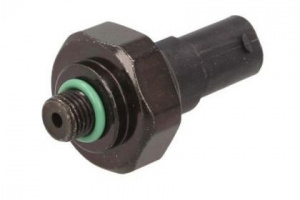
Level Sensor (B22/3, B22/8, B22/9)
The Level Sensor (1) function is to detect the vehicle height at the front axle and rear axle and supply the values to the AIRmatic with ADS control module.
The Level Sensor works by detecting the vehicle height using a link rod from upper transverse control arm at left and right front axle. A sensor at the rear axle monitors the movement of the torsion bar and determines the average vehicle height.
The Level Sensors consist of two Hall Effect sensors in a single housing which produce two signals (redundant design).
Sensor failure is detected by comparing the two redundant signals of each sensor.
Level Sensor Identification
Part Numbers:
- All 3 sensors have the same part number A0105427617 (EUR 150 OE, EUR 70 aftermarket) or A0105427717 (for vehicle with ABC suspension).
- Link for rear level sensor A2203200032 (EUR 40).
A common fault is rust on the link of the rear level sensor. The link can be fixed or even self-made.
- Link (rod) for front left/right level sensor A2203200389 (EUR 28)
- Sensor bracket front left - A2203270840 (EUR 70)
- Sensor bracket front right - A2203270940 (EUR 70)
AIRmatic Central Reservoir (42)
Metal compressed air reservoir. Stores compressed air for level control. Used for decoupling between compressor and level control.
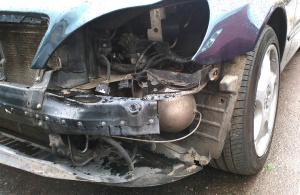
Comfort and sport switch (N72/1s3)
This switch controls Adaptive Damping System (ADS).
The switch with the indicator lamps is located in the upper part of the center console.
The ADS automatically selects the optimum damping for the respective driving conditions. At the same time the suspension is set to either sporty or regular.
The suspension tuning is set according to:
- Your driving style
- Road surface conditions
- Your choice of suspension style, "sport" or "convenience", which you select using the damping switch.
The following suspension styles are available:
- "Convenience" - both indicator lamps (1) are off.
- "Sports 1" - one indicator lamp (1) is on.
- "Sports 2" - both indicator lamps (1) are on (on vehicles produced after 09/99).
The selected suspension style is stored in memory, even after the SmartKey is removed from the starter switch.
Level Control Switch (N72/1s2)
This switch controls AIRmatic Level Control System.
The following vehicle level settings can be selected when the vehicle is stationary:
- "Normal" - for driving on normal roads. The indicator lamp (1) is off.
- "Raised" - for driving on rough roads or with snow chains. The indicator lamp (1) is on.
Select the "Raised" level setting only when required by current driving conditions. Otherwise the fuel consumption may increase and handling may be impaired.
The vehicle chassis ride height is raised or lowered according to the selected level setting and to the vehicle speed (these height adjustments are so small that you may not notice any change):
- With increasing speed, ride height is reduced by up to approximately 3/4 in (20 mm).
- With decreasing speed, the ride height is again raised to the selected vehicle level.
The selected vehicle level setting remains stored in memory even if the engine is turned off and restarted. However, the vehicle lowers to regular level when you exceed a speed of 75 mph (120 km/h) or maintain a speed of between 50 mph (80 km/h) and 75 mph (120 km/h) for more than 5 minutes.
This can be used to raise the vehicle level by 25 mm (20 mm USA). The raised level switch position is indicated by the red indicator lamp (1) in the switch. In addition, the multifunction display in the instrument cluster displays: "AIRMATIC VEHICLE RISING".
As long as the multifunction display in the instrument cluster shows the message: "AIRMATIC VEHICLE RISING", the desired vehicle level has not yet been reached. If the raising of the vehicle is cancelled due to the driving speed, the instrument cluster displays the following message for approx. 10s: "AIRMATIC LEVEL SETTING CANCELLED". If the vehicle is raised several times in quick succession, it may happen that the air compressor shuts down temporarily in order to prevent an overload. The raising sequence will then take an unusually long time.
AIRmatic with ADS Control Module (N51)
AIRmatic with ADS Control Module (N51) is located in left fuse box. Its task is to execute all control functions of ADS and AIRmatic.
The AIRmatic with ADS Control Module (N51) receives input signals over CAN Bus from the following components:
- ESP control module
- Engine control module
- Transmission control module
- Instrument cluster
- Steering angle sensor
- ADS comfort and sport switch
- Level adjustment switch
- Three body accelerometers
- Two front axle level sensors
- One rear axle level sensor
- One Airmatic pressure sensor
The input signals are converted in the AIRmatic with ADS Control Module (N51) to output signals for the following components:
- Four Level control valves
- One main reservoir charge valve
- Four ADS damper valves
- Multi-function display
- Switch indicator lamps
- Air compressor
AIRmatic Suspension Spring Strut (40, 41)
The Air Suspension Spring Strut takes over all the functions of suspension, level control, level adjustment and damping to be carried out.
Design of Air Suspension Spring Struts (40, 41)
A single-tube gas-filled damper unit or shock absorber is integrated into the air spring strut. A residual pressure valve is incorporated into the inlet fitting on the top of each air spring strut.
Design of Front Axle Spring Strut (40)
The Front axle air spring strut (40) consists of three main systems:
- Dust cover and protective boot called a bellows
- Air spring (strut top, residual pressure holding valve (k), seals, air bag/bladder (h) , strut tube (a))
- Gas pressurized damper or single-tube gas-filled shock absorber.
The coponents of the front axle spring strut are shown in the figures below. The air spring plunger is item 8 in the figure. It is the conical flared lower end of the protective boot or bellows. The air spring plunger fits over the support bushing which is the conical seat or item 9 on the damper unit.
Front struts on W220s up to about 2004 did not have epoxy installed at the factory. Also many of the older style front strut have now been modified with mastic or epoxy added. Note: The epoxy is not the seal for the upper strut. It is a vibration damper to help the narrow neck of the brass valve at the top of the strut avoid cracking and leaking due to vibration. If you have a leak in this older style front strut there is a kit you can buy to fix the leak (top seal repair kit A2203202538, see below). Scraping out the old black epoxy and filling it back in will not fix this. The part that leaks is a half metal and rubber cap under the black epoxy and is secured with a metal lock ring. The newer seals have rubber mastic compound poured in the center to seal the circumference of the upper metal cap on the upper part of the front strut and to keep the brass fitting from breaking off.
Operation of Air Spring Struts (40, 41)
- When filled with air, the rubber air bag or bladder (h) rolls up and down the alloy lower section strut tube (a).
- The strut tube (a) is covered by a protective boot or bellows.
- Without air and under load the protective boot or bellows is allowed to kink and crease and the air bag or bladder would also have the top pressed hard into the inside of the air chamber (l).
- The only sliding action is in the strut damper unit which is oil filled and gas pressurized.
Function of Air Spring Struts (40, 41)
The weight of the vehicle is carried by the compressible air (l) sealed into the air bag or bladder of the air springs. The rolling air bag or bladder (h) is made of rubber. Under dynamic load during driving, the air bag or bladder (h) rolls up parallel with the axis of the spring strut, thus providing the necessary spring travel. The roll-up zone on the air spring strut is sealed off from the outside by a rubber protective boot or bellows (n) as a protection against dirt.
The vehicle level is raised/lowered by increasing/reducing the air pressure in the air chamber (l), which results in a lengthening/shortening of the air spring strut (40).
Residual Pressure Holding Valve (k)
Each air spring strut incorporates a residual pressure holding valve (k) which blocks off the air spring pressure chamber from the supply line in the event of a pressure drop at or below a residual pressure of 4-5 bar.
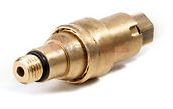
Parts (Spring Strut)
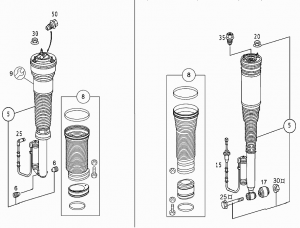
Front (without 4MATIC):
- A2203205113 (replaced by A2203202438)
- A2203202438
Front (4MATIC):
- Left: A2203202138
- Right: A2203202238
- A2203205013
- A2203207913 (for option code Z04)
- A2203207813 (for option code Z07) (replaced by A2203202338)
- A2203202338 (for option code Z07)
OEM (Bilstein):
Since Bilstein is OE manufacturer for W220 AIRmatic struts, it is possible to buy OE struts directly from Bilstein much cheaper. It is possible to purchase a brand new Bilstein strut for about EUR 700.
- Front left (4Matic): 44-051518
- Front right (4Matic): 44-051525
- Front: 44-042295
- Rear: 44-042301
Miessler Automotive
Miessler Automotive sells new struts having the same features as the OEM.
- Front: FBN0-002S-4229
- Rear: FBN0-002S-4230
- Front right (4Matic): FBN0-002S-2238
- Front left (4Matic): FBN0-002S-2138
Arnott sells both new and remanufactured AIRmatic struts. It is possible to get 10% discount [1] when making an order online.
Arnott claims [2] that their products use an improved double thickness air spring bag/bladder manufactured by Continental which provides longer lifetime than the OE.
In fact, Arnott provides limited lifetime warranty [3] for their AIRmatic Air Suspension Struts.
- Arnott Remanufactured . An Arnott remanufactured AIRmatic strut costs about US$575, but note that it only has installed a new rubber air bags/bladders and not the shock piston seals or gas charge.
- Arnott New . Arnott new Air Spring Struts cost about US$624.
Note that with all new Arnott AIRmatic struts you lose the electronic damping feature. While the new Arnott struts allow to plug in the original wire harness from the car, it simply fools the AIRmatic computer in to thinking the selective damping is functioning. In reality it is not and the shock has constant damping setting corresponding to OE "comfort/convenience" setting ("sport 1" and "sport 2" damping settings are not available).
Mechanical springs:
A mechanical spring version of the complete suspension strut which eliminates the pneumatic parts can be bought from Strut masters . This requires both sides to be replaced as a minimum, and possibly all four wheels should be done together. This method uses clever electronic components to "trick" the W220 computers into sensing that an AIRmatic is actually installed so that error messages are not displayed. The BIG disadvantage is the loss of air suspension ride quality, automatic leveling and damping options. In some countries such modified cars will not pass annual technical inspection.
Adaptive Damping System (ADS II)
Function of adaptive damping system (ads ii).
The Adaptive Damping System (ADS II) via the Damping Valve Unit (Y51, Y52, Y53, Y54) adapts the damping force to the driving style and road condition. The damping force is regulated in damping valves (Y51, Y52, Y53, Y54). Each wheel has one damping valve installed between the upper and lower chambers of the single-pipe gas-filled shock absorber.
Each damping valve contains two electromagnetic valves (y1, y2), allowing four different damping force settings according to how they are actuated via the AIRmatic with ADS control module.
The extremely short adjusting time (milliseconds) means that the optimum damping force setting is available almost immediately if sudden changes in the vehicle level are required, such as during an obstacle-avoidance maneuver.
Design of Damping Valve Unit (Y51, Y52, Y53, Y54)
- Y51 - left front axle damping valve
- y1 - front axle solenoid valve 1
- y2 - front axle solenoid valve 2
- p - piston reed valve pack
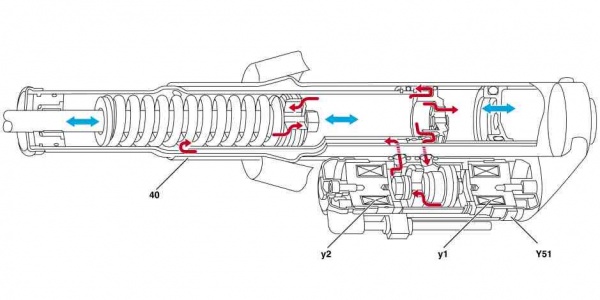
The Damping Valve Unit (Y51, Y52, Y53, Y54) consists of a casing and 2-piston reed valve packs (p). Located above are the spring-loaded solenoid valve pistons and the solenoids. The valve pistons and solenoids form the solenoid valve units (y1, y2).
If the solenoid valve coils (y1, y2) are not actuated, the spring-loaded solenoid valve pistons (y1, y2) keep the holes directly below them closed. Oil is displaced via the reed valve packs (p) and the oil duct located diagonally opposite in the casing.
If the solenoid valve coil (y1) is actuated, for example, the solenoid valve piston (y1) allows the hole to open and the oil can flow over this hole. Only a small amount of oil is displaced via the piston reed valve pack (p). The damping force levels are achieved by means of the differently positioned reed valve packs and controlling the solenoid valves.
Components of Damping Valve Unit (Y51, Y52, Y53, Y54)
Force settings.
The ADS suspension control module is used to achieve four different damping force settings:
The "Actuations" menu under the AIRmatic control module in DAS can be used to force a damping setting for a particular strut regardless of the ride conditions. The "Development data" menu (in German) can be used to force damping setting for all struts (F3 - the hardest setting, F6 - the softest setting).
Multifunction display (A1p13)
Various messages concerning the AIRmatic and ADS are shown in the multifunction display in the instrument cluster and in the comfort and sport and level adjustment switches.
AIRMATIC VISIT WORKSHOP!
In the event of electrical faults in the AIRmatic or ADS system, the following message appears on the multifunction display in the instrument cluster: "AIRMATIC VISIT WORKSHOP!".
The fault is stored in the ADS suspension control module and can be read out using the diagnosis tool.
Limp-home Function
A malfunction in the adaptive damping system causes the ADS to shut down. The suspension is switched to the hardest setting. In the event of a fault in the suspension system or in the level adjustment system, the vehicle attempts to maintain the set level. Manual and automatic level adjustments are no longer possible.
AIRMATIC STOP, CAR TOO LOW!
If the vehicle level at the front axle is more than 50 mm (60 mm USA), or at the rear axle more than 60 mm (70 mm USA) below the normal level, the multifunction display in the instrument cluster displays the warning: "AIRMATIC STOP, CAR TOO LOW!".
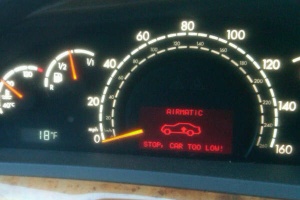
The display disappears again when the level has risen back to 48 mm or 58 mm (58 mm or 68 mm USA) respectively below the normal level.
Issues and Troubleshooting
Note : If the AIRmatic leaks substantially it is imperative that it be fixed as soon as possible or else the AIRmatic pump may burn out. If the leak cannot be fixed immediately remove the AIRmatic compressor relay (K40/7kO) to disable the AIRmatic Pump. For the relay and fuse locations see above. However BE WARNED , the vehicle may leak enough to be not drivable when turning the front wheels causes them to touch the top of the wheel arch (for 18" wheels and larger).
"AIRMATIC VISIT WORKSHOP!" message on the instrument cluster
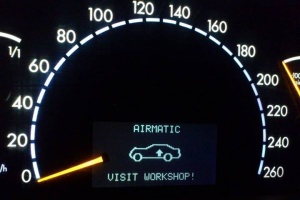
This message is shown in the event of electrical faults in the AIRmatic or ADS system. Use DAS to read error codes.
"AIRMATIC STOP, CAR TOO LOW!" message on the instrument cluster
Vehicle level too low.
Most common reason for a car being too low is a leaking strut. The strut itself has a residual pressure holding valve which is designed to stop air escaping out of the strut once the internal pressure drops below a residual pressure of 4-5 bar.
Note: the same symptoms as a leaking strut can be experienced if the line to the strut is faulty or the valve block is faulty (see section "Level Control Valve Unit Leaking" and "Inspecting AIRmatic Level Control Valve Unit (Y36/6) for leaks"), so be sure to eliminate these causes before replacing a strut.
Air Bag/Bladder Leaking
Usually the the most common source of a leaking strut is a failed rubber Air Bag/Bladder (h).
Failure is caused by the Air Spring Air Bag/Bladder (h) chafing against the protective alloy dust cover over time. The original Air Bag/Bladder (h) is made from a very thin single nylon cord layer, and vertical weak spots or lines will develop and eventually pop through, causing a complete failure.
Unlike the OE Air Bag/Bladder, re-manufactured ones usually use two ply rubber design that prevents vertical wear points and the Air Bag/Bladder is usually over two times thicker than the original one.
It is possible to replace a damaged Air Bag/Bladder (h), however, the rubber Air Bag/Bladder is attached to the strut tube and strut top with crimp rings. This requires access to an hydraulic crimper, which is not easily available for a DIYer.
Fortunately, it is possible to purchase on eBay a refurbished Air Spring which is the top part of an air suspension strut for around EUR 120 and mount it to the original damper unit (the lower part of an air suspension strut).
This requires the Strut to be removed from the car and the Air Spring to be separated from the Damper unit by partly dismantling the Air Spring. For the DIY Procedure see section "Replacing the Air Spring in an AIRmatic Strut".
If the leak is severe, a hissing sound can be heard from the wheel house area.
A faulty strut can often be located visually by observing the relative heights of each corner of the vehicle, but be aware that it is very likely that the wheel on the other side (or the wheel on other axle on the same side) will also be brought down significantly, but usually to a smaller extent.
To be thorough, an objective test is best performed.
- Ensure the vehicle is parked on a level surface.
- Measure the height at each corner of the vehicle and record the results.
Height Measuring Technique
Use a tape measure to measure from underneath the edge of a wheel arch to the centre of the M-B Star Logo in the wheel hub cap. This technique removes variations caused by tyre pressures.
- Do not disturb the vehicle for 10 hours. (Ensure the car remains "asleep" during this time.)
- Re-measure the height at each wheel and record the results.
- Calculate the drop at each wheel and compare with the specification.
M-B DAS states the drop in vehicle height must be less than 20mm (30mm in very cold conditions) in 10 hours, ie less than 2mm per hour is allowed.
Top Seals Leaking
The seals at the tops of the front suspension struts develop leaks. This issue was more common with the older design in the pre '03-ish W220's compared to those from a few years later. There is available an epoxy repair kit that can be used to close the cracks. A professional repair costs around US$550 parts and labor for both sides.
Note the newer W220's post '03 and ones which have been modified with new replacement parts do not leak at the top seal which is an 'O' ring around the metal cover disc. The top of the air suspension strut on these later models is filled with a butyl mastic compound to reduce vibration on the residual valve inlet connection.
Repair Options for AIRmatic Air Suspension Strut
If any AIRmatic Air Suspension Struts, Front axle (40) or Rear axle (41) need complete replacement, see the part numbers and replacement options.
For the DIY Procedures see the sections below.
Replacement AIRmatic Front Axle and Rear Axle Air Springs are also available and can be installed with the original damping unit (see sections below).
AIRmatic Compressor Unit Failure
AIRmatic Compressor Unit (A9/1) failure or partial failure. To test this hypothesis start the car and see if compressor is running (you should hear compressor in the front right fender running).
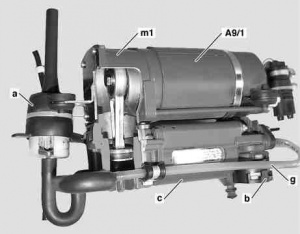
If it is not running, check AIRmatic Fuse and relay (see above). A faulty relay may cause compressor to run nonstop which will cause compressor to overheat and blow out the fuse.
Pressure Lines Leaking
The high-pressure line from the AIRmatic Compressor Unit (A9/1) to the AIRmatic Level Control Valve Unit (Y36/6) develops a leak. In this case replacement line or a repair joiner can be used.
It is possible that the pressure line to the strut develops cracks or micro cracks.
In case of front struts the line from valve block to strut can be tested with spray test.
However, in case of rear struts the line goes from the valve block to rear through interior and thus is not reachable. A simple test is to run an alternative line from the valve block to the strut to check if the original line is faulty (see the section on the line repair).
If the crack is large it may suffice to push air in the line and locate damaged point by hearing hissing sound.
Level Control Valve Unit Leaking
The AIRmatic Level Control Valve Unit (Y36/6) or valve block on top of the AIRmatic Compressor Unit (A9/1) fails (very common) and fails to close some valve.
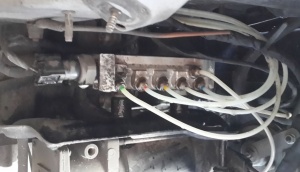
In this case the pressure will be released back to air compressor and out of the system.
For how to inspect valve block for leaks see the section "Inspecting level control valve unit (Y36/6) for leaks".
Usually, in case of valve block leak the vehicle will not be completely down, since the residual pressure holding valve at the air inlet to the struts will prevent the pressure dropping below a pressure of 4-5 bar.
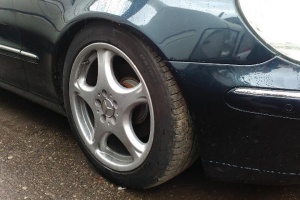
Central Reservoir Leaking
To test whether central reservoir can keep pressure DAS can be used which has a pressure test for reservoir.
If test shows that reservoir cannot keep the pressure, before replacing it, check with leak detector solution to test if the line to reservoir is faulty.
Level Sensor Faulty
There are two level sensors (B22/3, B22/8) for each front wheel and one for the rear axle (B22/9).
If the level sensor reports wrong height the system will think that vehicle already has the required level and will not raise the vehicle.
Information reported by level sensors can be viewed using DAS.
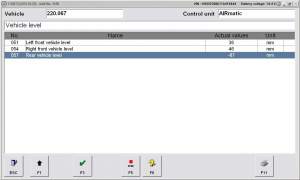
If the vehicle rises, but then falls down again, the level sensors are likely not the cause. If the vehicle is low, but there is no red error message in the instrument cluster about the vehicle level being to low, the level sensor (or its linkage) is at fault.
Vehicle Level Too High
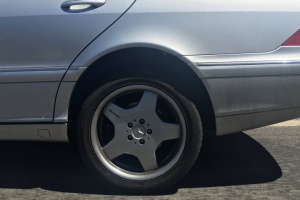
It is possible that Level Control Valve Unit (Y36/6) fails to close some valves in which case the pressure will be released back to strut raising the car too high.
The vehicle will be high only while the car is off, since as soon as vehicle is started the computer will try to adjust the level to the programmed level.
Compressor Unit Release Valve Stuck
When Airmatic ECU decides to lower the vehicle, the corresponding valve in the valve block is opened to release the air out of the system. The air is released through the always-open port P on the valve block. The compressor unit has electrically operated overpressure/residual pressure valve built in the unit. If this valve is stuck, the air will not be released out of system even if ECU sends the electrical signal to release valve built in the compressor unit.
The problem can be as trivial as broken connector. Usually instrument cluster will show malfunction and AIRmatic control unit will report an error:
Level Sensor Failure
There are two level sensors for each front wheel and one for the rear axle.
If the level sensor reports wrong height the system will think that vehicle level is too low and will rise the vehicle above normal height.
Protective Boot/Bellows Failure
On older and higher mileage vehicles the lower dust cover on an AIRmatic air suspension strut starts to wear and fail. This plastic protective boot/bellows is designed to prevent dirt and contamination getting to the air spring bag/bladder. After around 100,000 miles (130,000Kms) they often show signs of cracking and tearing. Failure to replace means the end is near for the whole strut.
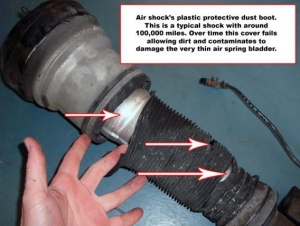
Upper Mount Rubber Bush Failure
A bumping or knocking noise coming from the top of the front suspension may indicate a worn upper mount rubber bushing in the Air Spring.
When the Air Springs were manufactured the upper mount rubber bushings were installed compressed. As the mounts weaken with age they can lose their compression and cause a bumping sound.
The image below shows a typical worn upper mount rubber bushing removed from an AIRmatic air suspension strut with around 80,000 to 100,000 miles (130,000KM to 161,000Km). A worn mount will also contribute to many unwanted problems with your air suspension.
Note the Upper Mount Rubber Bushing can be replaced without removing the strut for the car. Do the first steps as shown in the procedure described in section "Dismantling Front Air Spring".
It appears from inspection of the exploded diagrams for the AIRmatic front and rear struts that the upper mount rubber bush may be identical for the front and rear struts. NOTE This is yet to be confirmed.
Individual W220 Upper Mount Rubber Bushings are not readily available. Only available in lots of 5 on Ali Express [4] .

Emergency Procedure
In case of "AIRMATIC STOP, CAR TOO LOW!" warning on the instrument cluster, the vehicle should be stopped immediately and measures taken.
Possible consequences of riding with leaky strut:
- The compressor will run endlessly which may cause compressor burnout.
- If 18" or larger wheels are fitted, the tire will rub the inner fender.
- There is a risk of damaging other strut on the same axis.
There is a temporary fix for front struts, which can be used to get to the closest workshop:
The ride will be little bumpy, but not much harsher than it is when pushing the button that stiffens the suspension.
WARNING: Travelling long distances or over excessively bumpy roads with this temporary fix using a block of wood will damage the Transverse Control Arm Top (Upper Control Arm (UCA)).
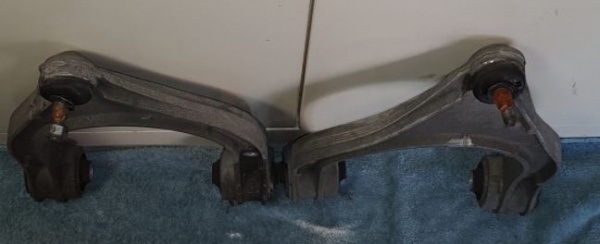
Note the much better location of the M-B limp-home buffer A2203271230 (1a) below which puts all the force over the ball joint and not the arm of the UCA.
Original M-B limp-home buffers
Front axle :
Mount limp-home buffer A2203271230 (1a) onto upper transverse control arm (6). Slowly lower vehicle and make sure that the limp-home buffer makes contact with top of wheelhouse.
Ŗear axle :
Slide limp-home buffer A2203280839 (1b) in between body fold and torsion bar (77). The body fold must lie in the groove of the limp-home buffer. Slowly lower vehicle and make sure that the torsion bar (77) makes contact with the limp-home buffer (1b).
- Depressurise AIRmatic components (suspension struts, valve unit, reservoir unit) before removal using STAR Diagnosis. WIS states that components or the entire system must NOT be discharged by unscrewing pressure line connectors although most DIYers have done this without problems. Just be sure to open any pressure line connections slowly to avoid a sudden loss of pressure.
- Soiled pressure line connectors must be cleaned before unscrewing.
- Mark the Level Control Valve Unit (Y36/6) with the colours of the air lines BEFORE removing them to avoid having to look up line and port designations.

- Seal off the exposed pressure line ports immediately with blind plugs if possible. A piece of masking tape over the holes is a short term solution.
- Seal off the pressure lines immediately to keep clean by placing the exposed ends in small plastic bags sealed with tape.
- WIS states you must only use flare nut wrenches or special tools to unscrew the pressure lines, however most DIYers have used 10mm open ended spanners successfully. Just be careful to not round the hex head.
- Use a high temperature silicon grease such as Permatex 22058 Dielectric Tune-Up Grease to lubricate high pressure pipes, threads and O-rings. It is also a good idea to apply a small quantity of dielectric grease to any electrical plugs and sockets when re-installing them. This helps keep air and moisture away and stops corrosion. It also makes it infinitely easier to remove the connections next time.
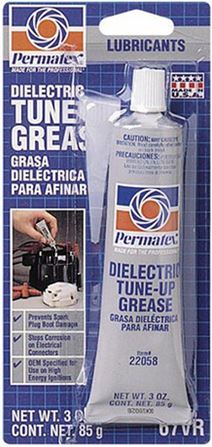
- Make sure to do a thorough leak test after reassembling any high pressure air line connection as the O-ring is easily damaged. A very strong mix of household dish washing liquid detergent and water will act as a leak detector. Another good leak detector solution is Party Bubble Mix. It is best to paint the solution on rather than spray it which creates heaps of unnecessary bubbles. Inspect the wet connection as the bubbles caused by a cracked O-ring can be small and may develop very slowly. Failure to detect the damaged O-ring in the next figure cost the author two new rear struts as it was the O-ring slowly leaking and NOT one of the struts as was mistakenly diagnosed.

- Replacing one stut at a time is possible as long as the valve block has no problems. The valve block has a valve for each strut supply pipe and if the valves remain closed then no air will leak from the other struts whilst one strut is off. But be warned , if the valve block is faulty then any of the struts could loose air after releasing the supply line from a strut.
- The Allen head Stub Screws holding the bottom of the front strut use Loctite thread fastener so a little heat from a gas torch always does the trick in breaking the sealant.
- Do not fully remove the Stub Screw, just unscrew them so that about five threads are showing. It is very easy to damage the threads when reinstalling.
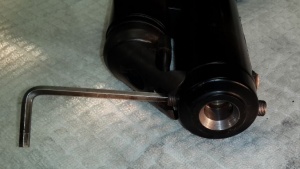
- When reinstalling a strut ensure that the plug at the electrical connection is pressed home firmly. TIP : Re-read the tip re Dielectric Tune-Up Grease and electrical connections. If the plug and socket have been cleaned and lubricated you should hear an audible 'click' when the connector is pushed fully home.
DIY Repairs
Before attempting any DIY repairs make sure to read the tips section above.
Testing strut for leaks
It is common to misdiagnose leaking valve block or line to the strut with leaking strut. Before replacing the strut, the leak should be verified by directly pumping the air to the strut and observing if the strut loses the air.
For this purpose a strut bypass valve below can be used. Pumping the strut requires to provide up to 10 BAR pressure. The usual Chinese 12v car tyre air compressors will fail long before that. We have achieved good success using Alca 227000 2-Cylinder 12v compressor.
Parts needed:
- G1/8" Schrader valve (EUR 1)
- G1/8" pneumatic fitting for 2.5*4mm pipe (EUR 1)
- Pipe 2.5*4mm 10m (EUR 6)
- MB connector A0003270369 (EUR 4)
- Compressor able to push 10 BAR at least
Inspecting AIRmatic Level Control Valve Unit (Y36/6) for leaks
Here's how to do a general leak test which will uncover most of the problems caused by faulty valve block.
On the right-hand side of the vehicle remove the wheel and part of the wheel house inner panel in front fender.
- Paint or spray the pressure line connections 1, 2, 3, 4, 5, P of the level control valve with leak detecting solution.
- Inspect for an indication of leaking. Severe leaks are evident immediately. Minor leaks can develop very slowly so be patient.
- The leak can come also from the body of the valve block (valve block is glued together from two parts).
- Wait for approx. 10-15 minutes after applying the solution and reinspect. This means that minor leaks can be recognized (forming a white cap).
Common failure mode of the level control valve unit (Y36/6) is when some valves fail to close thus releasing the air out of system through the compressor-controlled port 'P' or through other valves back to struts.
To test for a leak in any valves of the valve block:
- Make sure that all valves are under pressure (struts and reservoir have pressure in them).
- Detach the connector of 'P' port and spray the port with leak detection spray. Alternatively the 'P' line can be disconnected at the air compressor end and immersed in a soapy solution (see below).
- After the test use compressed air to clean the valve.
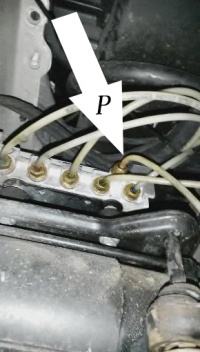
Leak Testing Using STAR Diagnosis System (SDS) or Diagnosis Assistance System (DAS)
According to WIS, STAR Diagnosis System (SDS) offers an easy and thorough method for testing the AIRmatic. However, be warned that a very small leak caused by a cracked or damaged O-ring on one of the air line connectors may still pass the SDS AIRmatic Pneumatic Tests.
Using SDS navigate to AIRmatic Pneumatic Tests.
The following tests are available;
- A9/1 Compressor Test
- Y36/6y1 Left Front Strut Test
- Y36/6y2 Right Front Strut Test
- Y36/6y3 Left Rear Strut Test
- Y36/6y4 Right Rear Strut Test
- A9/1y1 Pressure Relief Valve Test
- Leak test between compressor and valve block (line between compressor and 'P' port in valve block).
- Leak test between valve block and suspension struts.
- Central reservoir charge valve (in valve block) is opened.
- All other valves (in valve block) are closed.
- Compressor is turned on for <60 secs.
- Compressor is turned off.
- Compressor keeps the line to 'P' port (in valve block) closed.
- Central reservoir pressure is monitored for leakage for 120 secs.
- The Central reservoir pressure must not drop by more than 0.5 bar in that time.
1. Leak test between compressor and valve block (line between compressor and 'P' port in valve block).
As an example, the following result was obtained for a leak test for a FAULTY 'P' line to Level Control Valve Unit (Y36/6) or Valve Block. This is similar to the test using soapy solution.
- After all valve block valves were closed the compressor produced 10.56 bar within 10 secs which is INSIDE the specification of 10 bar within 40 secs.
- After the compressor was turned off the initial compressor pressure ('P' line) = 10.56 bar.
- After the 120 elapsed time the final compressor pressure ('P' line) = 5.30 bar.
- Thus the measured leakage rate was 5.26 bar in 120 secs which is OUTSIDE the specified 0.5 bar in 120 secs.
- SDS reported that there was a leakage in the valve block or the high pressure line between the compressor and the valve block ('P' port).
A squirt of some soapy solution on the high pressure line between the compressor and the valve block proved that the line and its associated connectors were not leaking. Thus the fault was a leak in the valve block. Once the 'P' port connector was removed from the valve block, a simple test by applying a soapy finger over the port produced obvious positive pressure of air escaping from the port, thus confirming the diagnosis of a leaky valve in the valve block.
Unfortunately the valve block can not be dismantled for inspection and cleaning thus a new Level Control Valve Unit (Y36/6) was required.
As a comparison, after replacing the Level Control Valve Unit (Y36/6) or Valve Block with a BRAND NEW OEM part, the following result was obtained for a leak test.
- After all valve block valves were closed the compressor produced 10.8431 bar within 10 secs which is withing the specification of 10 bar within 40 secs.
- After the compressor was turned off the initial compressor pressure ('P' line) = 10.8431 bar.
- After the 120 elapsed time the final compressor pressure ('P' line) = 10.8431 bar.
- Thus the measured leakage rate was 0.0 bar in 120 secs which is INSIDE the specified 0.5 bar in 120 secs.
2. Leak test between valve block and central reservoir.
As another example the following result was obtained for a leak test between valve block (Level Control Valve Unit (Y36/6)) and central reservoir for a FAULTY Level Control Valve Unit (Y36/6) or Valve Block.
- Initial Central Reservoir pressure = 12.07 bar reached in 60 secs.
- After Compressor turned off the Central Reservoir pressure = 10.84 bar.
- After 120 secs elapsed time the Central Reservoir pressure = 10.57 bar.
- Conclusion: This real world Central Reservoir and its associated supply line after 220,000Km produced a leakage rate of 0.27 bar in 120 secs, which is well within the specified 0.5 bar in 120 secs.
As a comparison, after replacing the Level Control Valve Unit (Y36/6) or Valve Block with a BRAND NEW OEM part, the following result was obtained for a leak test between valve block (Level Control Valve Unit (Y36/6)) and central reservoir.
- Initial Central Reservoir pressure = 7.549 bar reached in 60 secs.
- After Compressor turned off the Central Reservoir pressure = 7.41177 bar.
- After 120 secs elapsed time the Central Reservoir pressure = 7.41177 bar.
- Conclusion: This real world Central Reservoir and its associated supply line to a brand new Level Control Valve Unit (Y36/6) or Valve Block produced a leakage rate of 0.0 bar in 120 secs, which is well within the specified 0.5 bar in 120 secs.
Replacing Compressor Unit
- If possible depressurise the AIRmatic system using STAR DAS.
- Disconnect battery.
- Remove engine compartment paneling (right front part only).
- Unscrew pressure line connection (1) from AIRmatic compressor unit (A9/1).
- Detach connector on AIRmatic pressure reduction valve (A9/1y1).
- Disconnect connector for air compressor motor (3).
- Pull intake hose with air filter (2) out of longitudinal member.
- If the AIRmatic air filter (2) is replaced, the arrow on the air filter (2) must point upwards .
- Unscrew nuts (arrows) and remove AIRmatic compressor unit (A9/1).
- Detach air compressor relay (K40/7kO). Only when installing a new air compressor. When replacing the air compressor the air compressor relay (K40/7kO) should always be exchanged as the switching contacts may be damaged.
- Install in the reverse order.
Compressor Unit Repair
If the compressor unit is not able to provide pressure, the most common fault is worn piston ring or cylinder head inside the air compressor. The piston ring within the compressor unit of your air suspension system deteriorates over time. The OEM piston ring is made from a soft plastic that wears quickly, this wear substantially reduces the output of your compressor leading to noisy, slow rising or non-rising suspension. There are available piston rings with improved design.
Few notes to take into account:
- The replacement of piston ring will not help if the cylinder head is damaged/worn. Inspect head for damage and clean it from dust. There are also compressor repair kits that include new cylinder head.
- It is not uncommon for the torx bolts attaching piston head to the compressor to break. Make sure to order spare bolts with the kit and be prepared to drill out the old remains.
- While at it, don't forget to replace air dryer desiccant (silica gel) and dust filter.
Valve Block Repair
The most common faults and diagnosis:
- Fault in electrical solenoid valve. Can be tested by supplying 12v voltage to the pins of electrical connector. In case of failure the repair is not possible (all valve solenoids are part of one big monolith).
- Due to oxidation process the valve block separates and lets the air through (see picture below). Possible to clean the oxidation layer and reattach the halves.
- Valves do not close tight, letting the air through. Oxidation layer can be cleaned with some reagent. O-rings can be changed (see below).
- Bad pressure sensor (usually misdiagnosed). Pressure sensor can be replaced separately.
- Rusty or broken electrical contact pins of pressure sensor or valve control.
O-ring repair kit
There are sellers on eBay who sell valve block O-ring repair kit with set of 18 O-rings (~30 EUR).
Instructions:
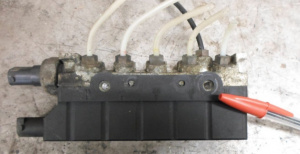
- Douse with the whole assembly with WD40 or similar and wriggle, wriggle and wriggle until the two halves of the valve block come free.
- When reassembling the two halves of the valve block, add only the smaller o-rings to the solenoid posts, and put the larger o-rings into the recesses on the underside of the metal block and ensure they are well seated. This helps with reassembly to ensure the larger solenoid o-rings do not get damaged or misaligned when putting back together. You may find the larger o-rings getting nipped/cut if reassembled with them on the posts.
- On the underside of the metal block around the ports which the solenoid pins engage, there are some very small slots which marry up with some very small plastic moldings on the solenoid block. Ensure these slots are cleaned of any deposits. You can use a pin and a razor blade to tease out the deposits. Doing this will help ensure a nice snug fit when putting back together.
- Use a dielectric grease sparingly on the o-rings.
- Ensure all deposits are cleared off, and use an airline to blow through all the passages.
- You may need to use a vice carefully to press the solenoid block and metal block back together. Ensure the plastic cover clips well over the metal lugs on the metal block.
Line Repair
For the location and routing of the AIRmatic air lines see above.
If you have diagnosed a leak in any of the AIRmatic pneumatic lines, the repair options are to:
- Cut out the failed section and reconnect using an in-line joiner.
- Replace the failed section of air line with a M-B repair kit (5 ft length only available).
- Replace the complete air line with an aftermarket high pressure flexible nylon pneumatic line.
- Bypass the complete air line with an aftermarket high pressure flexible nylon pneumatic line.
The air lines to the rear struts go through the interior and it may be difficult to find the leak unless the crack is large enough so that the crack can be located thanks to a loud hissing sound. Alternative line can be run from front valve block to the rear to test if the line is faulty.
M-B sells the AIRmatic air line (pipe/hose/tube) in 5 ft lengths, maximum. From the factory, the air line is built using a continuous length of line with no joins. The M-B 5 ft lengths are just for repairs, so connectors will be needed.
However, you can buy aftermarket 4x2.5mm nylon high pressure flexible pneumatic lines of any length which are much cheaper than OEM lines (search keyword "4mm Hose Flexible Nylon Natural / Tube Pneumatic Air Line / 5m Roll"). Various colours are available and can be used to match the OEM colour code.
M-B also sells an air line repair connector (junction/fitting) A0003270169 which can be used to re-connect an air line after cutting out the broken section. However, there are also available cheap and reliable plastic "push in" connectors which can be used to easily connect air lines without any tools.
Leaking Front Strut Air Spring - Repair Options
Leaking front strut air spring
Air spring of the front suspension strut is shown in the next figure. The lower flared conical part of the air spring protective boot/bellows (n) is the "air spring plunger". The plunger mates to the "support bushing/bearing" which is the conical shaped seat on the damper unit.
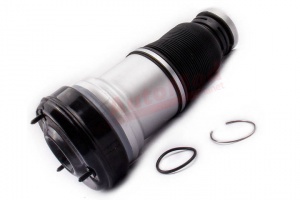
A common issue when a Front Suspension Strut deflates completely and the car is then jacked up so that the strut is fully extended is that the Air Spring Plunger separates from the Damper Support Bearing.
Note: Air suspension struts on which the Air Spring Plunger (7) is separated from the Support Bearing can sometimes be filled with air again without problems. They do not necessarily need to be exchanged for a new suspension strut. However the strut must be filled while the protective boot/bellows (n) is aligned to the Damper Support Bearing. The method is to pressurize the suspension strut using STAR Diagnosis and at the same time press the Air Spring protective boot/bellows upwards as far as it will go to remove any crinkles. Then pull it smoothly and evenly downwards and press onto the support bearing. No air must escape from the plunger to support bearing contact surface otherwise pressure can not be built up in the Air Spring.
For an AIRmatic strut to deflate completely there may be a catastrophic failure of some internal component such as the air bag/bladder (h), but it can also mean that the residual pressure holding valve (k) is leaking so that the strut deflates over time. This residual pressure holding valve (k) normally blocks off the pressure chamber in the air spring from the supply line and closes at or below a residual pressure of 4-5 bar. For a leaking residual pressure holding valve (k) to cause a full deflation, the air supply line or the relevant valve in the Level Control Valve Unit (Y36/6) would also need to be leaking.
A leaking Level Control Valve Unit (Y36/6) on its own should not cause the strut to deflate completely as the residual pressure holding valve (k) should be fully closed below 4-5 bar.
Before replacing a supposed leaky AIRmatic strut, always carry out a leak test on the head bearing using soapy water. Proceed as follows:
- Fill the air spring (using the DAS or other means), and in the process pull the air spring plunger (7) downwards firmly by hand so that the air does not escape between the air spring plunger and the Damper support bearing (picture 2 and 3).
- Once the suspension strut is filled, carry out the leak test on the head bearing and repair if necessary. A repair kit is available for this purpose.
- After using the repair kit proceed as described above when filling the air suspension strut (picture 2 and 3) ie pull the air spring plunger (7) firmly downwards by hand so that the air does not escape between the air spring plunger and the support bearing.
Repair options
If the head bearing is not leaking and the plunger is fully seated on the support bearing then the options are to;
- Replace the complete AIRmatic strut.
- Replace just the Air Spring of the AIRmatic Suspension Strut. (Note: This is the cheaper option but requires dismantling the failed Suspension Strut. It is a good option if the damper unit is in good condition. Refurbished Air Springs are available from Suspension Workshops.
Remove/install front suspension strut
If a replacement front axle spring strut (40) has been procured, it is quite an easy task to swap them over.
- Position wheels straight ahead
- Jack up the rear or just one side of the car as required. Support the car on stands.
- Remove f32 /40A (AIRmatic compressor fuse) from the relay box in engine compartment right. This is not strictly necessary, as the compressor should not engage if engine is not running.
- Empty suspension strut (40) affected using DAS . (Note: it is not strictly necessary to do this step - just be careful when opening the pressure line to release any residual air slowly.)
- Unscrew pressure line connection (40a). Remove the pressure airline from the head of the strut using 10mm open ended spanner. Residual pressure in suspension strut up to 3.5 bar. Plug the pressure line for the duration of the repair operations. Installation: Check pressure line O-ring and replace if necessary.
- Unscrew nuts (40b) on front end. Remove the three upper mounting nuts (13mm) at the strut head. Installation: Fit nuts (40b) then refill suspension strut in fully-assembled vehicle before torquing to specification (lightly tighten the three strut upper mounting nuts - they will be torqued fully once the car is ready to drive ).
- Disconnect left front axle multiple circuit junction connector, major assembly compartment (X62/7) right front axle multiple circuit junction connector, major assembly compartment (X62/6). Connectors of damping valve unit and rpm sensor. Press against spring (arrow) to remove. (Note: WIS says to press down on the spring retaining clip to release the multi-electrical connectors.) If necessary the multi-electrical plugs X62/6 or X62/7 can be released by praising the spring retaining clip upwards. Separate the front strut multi electrical connector into two connectors thus releasing the front strut so that it can be removed.
- If required, apply heat to the bottom allen stub screws. Several people have reported difficult screw removal resulting in several broken hex wrenches, frustration or even stripped set screws that had to be drilled out. A very effective method to remove the screws is to use heat from a blow torch. A micro torch provides a nice small sharp flame that is easily controlled as to not cause any collateral damage.
- Loosen the two bottom allen stub screws (5mm hex Allen key). Do not fully remove the stub screws, just unscrew them so that about five threads are showing.
- Loctite can be added to the exposed threads before installation. Note: It is very easy to strip the thread when starting the stub screws in dirty holes on an old damper unit. Not completely removing the stub screws during disassembly eliminates this problem. If a stub screw mangles the start of a thread, remove the Air Strut to a work bench and thoroughly clean the threads on both holes. They will be full of old Loctite sealer. Then screw a stub screw into the 'good' side and keep screwing it all the way through until it comes out the far side, and in the process reshaping the mangled thread. Do this a couple of times and the stub screw should then start properly. It is far easier to start the stub screws on a work bench than when in the car.
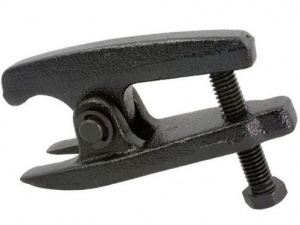
- Remove spring strut (40) downwards towards the side. Installation: When installing tighten the upper nuts (40b) first.
- Fill suspension struts (40) in question using DAS . Pressurize to 5 bar. During filling the wheels must not contact the ground, as when filling in the deflected condition the air spring bellows in the suspension strut (40) is destroyed. In other words: Never completely lower the vehicle if the air shocks are not pressurized. Lower the jack partly until the car is at normal vehicle height (lower vehicle until distance axle center to lower edge of fender is about 400mm). Start the engine and wait for at least two minutes for everything to stabilize.
- Check AIRmatic for leaks.
- Install in the reverse order
Torque specifications:
- Nut, front suspension strut to front end: 20 Nm
- Bolt, front suspension strut to spring control arm: 20 Nm
- Air suspension pressure line to front suspension strut: 5 Nm
Excellent replacement tutorials for the front struts are available here:
Remove/install rear suspension strut
Replacing rear strut is more time consuming than replacing front strut.
- Depressurize suspension strut concerned (41) using DAS . (Note: it is not strictly necessary to do this step - just be careful when opening the pressure line to release any residual air slowly.)
- Jack up one side of the car as required. Support the car on stands.
- Remove rear wheel.
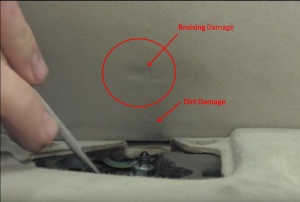
- Unscrew pressure line connection (41a) using 10mm open ended spanner . Be warned : pressure in the line between the valve block and the suspension strut can be very high so if pressure has not been released using DAS , slowly unscrew the valve allowing the residual pressure to escape. (The residual pressure valve on the top of the strut prevents the release of the last bit of pressure. Residual pressure in suspension strut is up to 3.5 bar. This means that the strut will still exert considerable force on the suspension components.)
- Plug the pressure line for the duration of the repair operations (just to make sure that dirt does not get in) .
- Unscrew nuts (41b) using the smallest 13mm socket and driver available .
- Pull off grommet and disconnect electrical connector of damping valve unit (Y53x1/ Y54x1)
- Remove bolts (or plastic rivets) (72d) on spring control arm cover (72c). Remove spring control arm cover (72c).
- Detach brake caliper from the wheel. Disconnect brake wear sensor and remove brake wear sensor bracket (right side only). The removal of brake caliper is not strictly necessary if vehicle is lifted high and hence there is enough space to pull out the strut downwards.
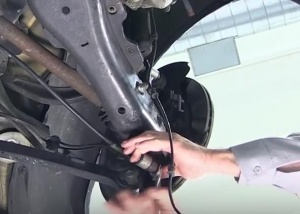
- Pull down track control arm (72) and remove strut assembly (41) by lowering it and pulling it out to the side.
Installation:
- Install strut by loosely fitting nuts (41b). (The vehicle must be in the ready to drive mode when torquing these three nuts.)
- Install bolted connection (2) of suspension strut (41) on spring control arm (72). (The vehicle must be in the ready to drive mode when torquing this bolt.)
- Install bolted connection (1) of thrust arm (4) on rear axle carrier (if this bolt was loosened or removed). (The vehicle must be in the ready to drive mode when torquing this bolt.)
- Reattach stabilizer bar link bottom nut
- Install bolted connection of spring control arm (72) and wheel carrier by wriggling the wheel carrier (use a jack to raise spring control arm as needed). (The vehicle must be in the ready to drive mode when torquing this bolt.)
- Route strut's electrical line and reconnect connector of damping valve unit (Y53x1/ Y54x1)
- Attach spring control arm cover (72c)
- Reattach brake caliper (if was removed)
- Reattach wheel
- Screw pressure line connection (41a)
- Fill suspension struts affected using DAS . Pressurize to 5 bar. Warning: During recharging the wheels should never be in contact with the floor; refilling with the suspension compressed leads to destruction of the air suspension bellows in the strut (41). If DAS is not available, start the car and check that the strut gets pressurized. If the strut is not being pressurized, stop the car, lock, unlock and start the car again. Operate Level Control Switch (N72/1s2) to force strut height adjustment.
- Release the car from the jack slowly to check that the strut has enough pressure. Do not release the wheels fully before the struct has enough pressure.
- Check that the car is on the ground and the vehicle is fully supported on the new strut.
- Torque three fitting nuts (41b).
- Attach cover (arrow) in parcel shelf. Reattach C-pillar.
- Torque bolted connection (2) of suspension strut (41) on spring control arm (72)
- Torque bolted connection (1) of thrust arm (4) on rear axle carrier (if this bolt was loosened or removed)
- Torque bolted connection of spring control arm (72) and wheel carrier
- Check for leaks
- Suspension struts: Nut, rear suspension strut to body: 20 Nm
- Suspension struts: Air suspension pressure line to rear air spring: 5 Nm
- Suspension struts: Nut, rear strut to spring control arm: 110 Nm
- Spring control arm: Self-locking nut, to rear subframe: 50 Nm + 90 degrees
- Spring control arm: Self-locking nut, to rear axle carrier: 70 Nm
- Stabilizer bar link bottom nut: 40 Nm
Excellent replacement tutorials for the rear struts are available here:
Replacing the Air Spring in an AIRmatic Strut
As already described, a very common reason for a leaking strut is damage in the strut's rubber air bag/bladder (h). It is possible to purchase on eBay a refurbished front and rear air spring which is the top part of an air suspension strut for around EUR 120 and mount it to the original damper unit (the lower part of an air suspension strut). This requires the strut to be removed from the car and the air spring to be separated from the damper unit by partly dismantling the air spring. Note: Replacing only the strut's rubber air bag/bladder (h) of the air suspension strut is not suitable for a DIY project as it requires an hydraulic crimping tool.
Dismantling Front Air Spring
- Remove the complete front axle AIRmatic spring strut (40) from the vehicle.
- If required close the opening of the residual pressure holding valve (k) with a short bolt M8, so that no dirt can penetrate into the air suspension strut.
- Remove the snap ring. ( TIP : Use a small screwdriver to help remove the circlip lock snap ring but make sure it does not cause any scratches and burrs, otherwise the sealing of the new lock ring may be compromised. Remove any sharp edges or burrs if required.) (Note: a new circlip lock snap ring is provided in the top seal kit, see below.)
- Remove the tool.
- Inspect the inside of the top of the Front Strut for any sharp edges or burrs and remove if required.
- Use an air impact driver to undo the lock nut on the top of the damper piston rod (e). (Note: unfortunately it is essential to use an impact wrench as the piston rod in the damper unit can not be restrained from turning. The impact wrench shocks the nut undone.)
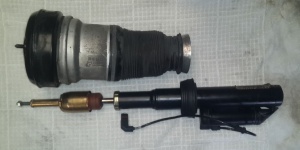
- The yellow arrow points to the hole going through the upper mount rubber bush for the damper piston rod (e).
- The blue arrow points to the inside of the Air Spring for the rubber air bellows (h).
- The red circle shows the threaded brass air inlet to the Air Spring.
Reassembly Front Air Suspension Strut (40)
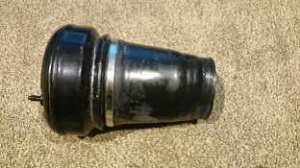
- The bottom end or plunger of the lower strut tube (a) is tapered which is for sealing to the support bearing on the damper unit.
- Note: the Airmatic strut can leak air from the bottom of the lower section if not seated against the rubber of the damper unit correctly.

- Install the protective boot/bellows to the top dust seal alloy cover.
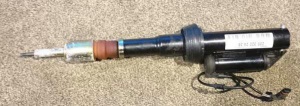
- (left image) the strut top plate with the hole for the damper,
- (center image) the strut top plate with the upper mount rubber bush in place waiting for the nyloc nut, (Note: an impact wrench is used to tighten the nut (with Loctite applied) to the damper piston rod.)
- (right image) the strut top with the nylon cover placed over the nut.

- Install the residual pressure holding valve (k) using the commercial tool or DIY modified spanner.
- Support the strut vertically and fill the top of the strut with a black butyl mastic to reduce vibration damage to the air inlet valve. TIP : If a pour-able butyl mastic can not be sourced, Sika manufacture a range of butyl mastic sealers which can be extruded in thin layers (5mm thick). Use a spatula to smooth the layer evenly and then leave it to set. Repeat the layering process until the cavity is filled. The result is not as neat as the OEM but it does the job. If required the extruded layers technique can be done with the Air Strut installed in the car as the compound is quite viscous and will not run.
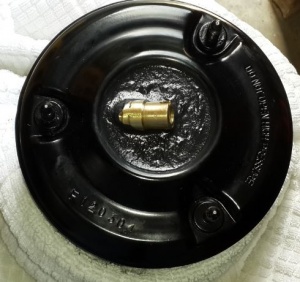
Tools Required for Replacing Air Spring in Front Air Suspension Strut (40)
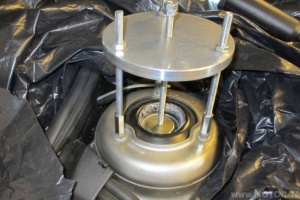
- Draw the two diagonals to establish the centre of the plate.
- Mark with a centre pop.
- Set a divider to 61.5mm radius.
- Draw a circle with the divider around the centre pop producing the pitch circle diameter of 123mm.
- Centre pop the first hole on one of the diagonals.
- Use the divider still set to a radius of 61.5mm and mark six arcs around the circumference of the PCD. This divides the PCD into six equal chords. (Alternatively set the divider to 106.5mm and scribe across the PCD in two places.)
- Centre pop the required intersections for the other two 8mm holes.
- Visually check that the centre pop marks match the pitch circle diameter (pcd) of the strut top plate mounting bolts.
- Drill the three off 8mm holes.
- Drill one 10mm hole in the center.
- Obtain three off 120mm long 8mm bolts for the three 8mm holes.
- Use three 8mm joiner nuts to attach the 8mm bolts to the strut top. (Alternatively four off 8mm nuts can be welded together to make one off 'long' nut.)
- Obtain one off 150mm long 10mm bolt for the center 10mm hole.
- Thread a nut right to the top of the 10mm bolt and add a flat washer with a little bit of grease.
- Impact driver (Note: is absolutely essential for removing the nut at the top of the damper unit.)
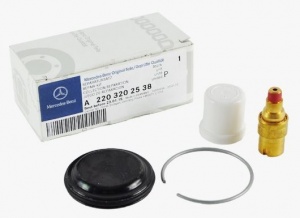
Excellent replacement tutorials for the front and rear struts are available here:
Remove/install front axle level sensors
Remove/Install:
- Replace self-locking nuts and bolts
- Remove front wheels
- Disconnect connectors at front left and right level sensors (B22/8, B22/9)
- Unscrew nut (86c) on connecting rod (86) from front left and right level sensors (B22/8, B22/9)
- Unscrew nut (86b) on connecting rod (86) from upper wishbone (6) and remove connecting rod (86). Installation:Attach connecting rod (86) to the outermost hole (f) on the upper wishbone (6).
- Unscrew bolts (86d) on retaining plate (86a) and remove front left and right level sensors (B22/8, B22/9)
- After replacing the level sensors, calibrate vehicle level with Star Diagnosis (level calibration)
Torque specification:
- Nut, level sensor connecting rod to upper wishbone: 10 Nm
- Nut, connecting rod to level sensor: 5 Nm
- Bolt/nut of level sensor to retaining plate: 4 Nm
Remove/install rear axle level sensor
- Disconnect plug from rear axle level sensor (B22/3)
- Unscrew nut (85e) of control rod (85) from stabilizer bar intermediate lever (81)
- Unscrew nut (85d) of control rod (85) at level sensor (B22/3) and remove control rod (85). Do not separate control rod (85) or change the adjustment.
- Remove bolts (85c) of retaining plate (85a) at level sensor (B22/3) and remove level sensor (B22/3)
- Calibrate vehicle level using Star Diagnosis after replacing the level sensor
- Nut, level sensor link rod to torsion bar intermediate lever: 10 Nm
- Nut, control rod to level sensor: 5 Nm
- Bolt, level sensor to retaining plate: 4 Nm
- Nut, retaining plate to frame floor: 8 Nm
Airmatic Adjusting Levels Using STAR Diagnosis System (SDS) or Diagnosis Assistance System (DAS)
See Section Airmatic Adjusting Levels Using DAS
Navigation menu

- Search forums
- Suspension, Steering & Brakes
W220 air matic visit workshop
- Thread starter dean fitton
- Start date Jan 13, 2016
dean fitton
Senior member.
- Jan 13, 2016
Quick question for someone to hopefully answer. My s class pre face lift has airmatic visit workshop. However it will raise to max but it will not lower. The only way to do this is to bleed the air out one of the front lines. Has this happened to anyone else? If yes what caused it and how did you fix it? Thanks
Forum Supporter
Sounds like the wiring to the compressor has broken, there is two plugs there, one large feed and the other is the release valve, this wire is prone to braking......not always easy to see at first....
- Thread Starter
- Thread starter
At the plug end of the release valve or further up pls? Normally I guess you would put an overlay loom in? Thanks
Plug end on compressor sir...
- Feb 19, 2016
Tested it all ok. Looking to check wiring to ecu.
Always remembered RIP

- This site uses cookies to help personalise content, tailor your experience and to keep you logged in if you register. By continuing to use this site, you are consenting to our use of cookies. Accept Learn more…
- My Playlist
- TV Commercials
- Video Categories
- Watch History
- Watch Later
BenzInsider.com – A Mercedes-Benz Fan Blog
- C-Class Coupe
- C-Class Estate
- E-Class Cabrio
- E-Class Coupe
- E-Class Estate
VIDEO HIGHLIGHTS

4 Ways to Successfully Reset a Mercedes Airmatic Problem
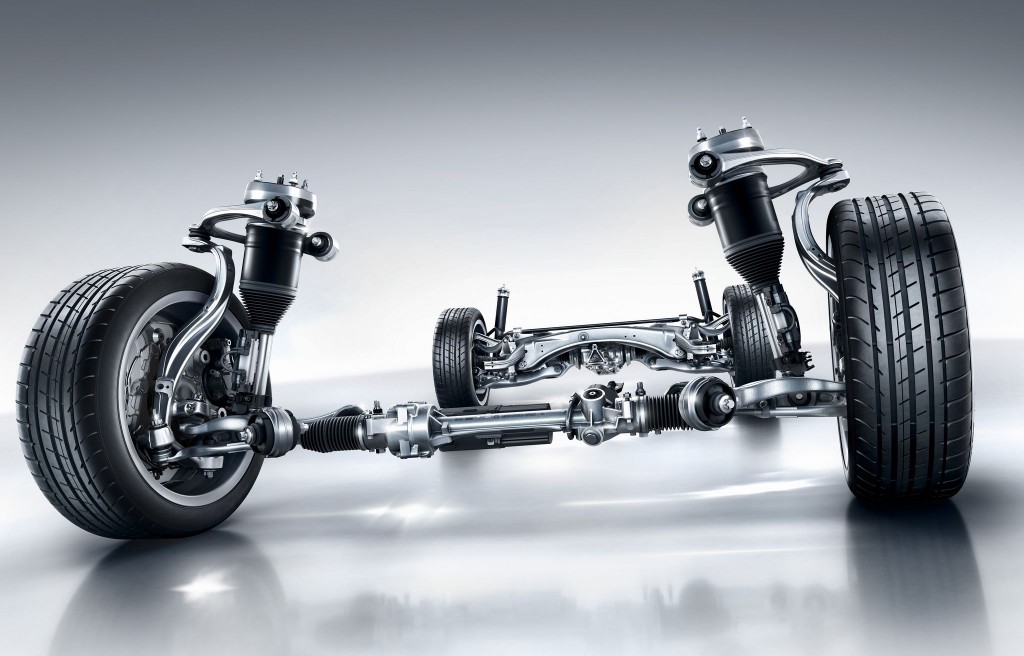
If you are experiencing a Mercedes Airmatic problem, yet there are no parts damage on your end and you suspect that it is only a glitch in the electrical system causing it, there are ways to reset the system to bring it back in order. In this article, we will provide you with some quick tips to safely reset the Mercedes Airmatic system to bring it back to its correct operation.
The most common ways to reset the Mercedes Airmatic suspension system are thru a battery reset, onboard diagnostics (OBD) system reset, specialized Mercedes lowering tool, and electronic control unit (ECU) reflashing.
About the Mercedes Airmatic System
In 2000, Mercedes-Benz introduced its revolutionary air suspension system known as “ Mercedes-Benz Airmatic ” in the W220 S-Class series including trims such as the S430 and S550. Subsequently, this cutting-edge technology spread to other popular models from that period like GL450, E500 (W211), R350, and CLS550.
Utilizing an advanced combination of air springs with electronic level control and adaptive damping, the Airmatic is engineered to provide a ride experience that is incredibly comfortable for passengers or that can complement the performance of the car in various road conditions. This technology has stood the test of time as it remains standard equipment on the S-Class, CLS, GLE Coupe, and GLS SUV while others have it as an optional feature.
Key Symptoms of Mercedes Airmatic Problems
When it comes to diagnosing the underlying problem, you should watch out for certain indicators that directly point out to a possible problem in its system. It may manifest through one or a combination of the following:
1. Dashboard Alert(s)
The most common warning signal is the dashboard message saying “Airmatic” usually followed by either “Visit Workshop” or “Car Too Low”. This alerts the driver that a fault has been detected in any of the system’s components or sensors.
Additionally, you may notice your vehicle sagging on one side indicating air leaks within an air spring.
3. Performance Issues
Furthermore, other performance-related symptoms like apparent instability while turning, banging noises during cornering at slow speeds, and jerking motions are indications of faults in this system.
4 Tips to Successfully Reset the Mercedes Airmatic System
Sometimes, dashboard warnings may go away after restarting your auto if the issue only stems from a minor system glitch in its system. However, if that does not cut it, you can turn to the alternatives shown here.
Since there is no single method to reset all systems related to the Mercedes Airmatic, you will need to initially refer to your car’s owner’s manual or from a customer support representative of your dealership for specific instructions. Generally, the procedure involves the following:
1. Resetting via the Car Battery
Turning off your engine and disconnecting the negative battery cable remains one of the traditional and often effective ways to address any electrical-related problem in a car. Once you do this, wait for at least 15 but not over 30 minutes before reconnecting the battery and starting your car.
2. Utilizing an OBD II Scanner
Some models of Mercedes require that you reset the system from an onboard diagnostic computer. In these cases, it is recommended to take your vehicle to a certified technician who can use their specialized equipment to troubleshoot any issues within the Airmatic system. However, if you happen to have access to an OBD II scanner capable of this and you’re up to the task, just check the product manual of your device and follow the directions provided by its prompts along the way to accomplish the procedure.
3. Mercedes Lowering Kit
If the warning pointing to a Mercedes Airmatic problem is coupled with sagging or noticeable performance issues, you can utilize a special lowering module designed for it. This is an OBD-2 plug-and-play system that takes around minutes to install on a compatible device. Afterward, you can use this module by plugging it into the OBD port of your auto to manually adjust its ride height.
How high or low it will go depends on the type of module you buy, your preference, and your vehicle specs. As always, it’s best to refer to and follow the recommended settings of Mercedes, or better, have a professional technician do the job for you.
4. ECU Reflashing
Finally, another way to treat Airmatic problems is to do an electronic control unit (ECU) reflashing. This entails updating the software of your car’s computer system, which is often done by using a specialized programming tool to correct any bugs or design flaws in the ECU. With this procedure, you can avoid future errors and further enhance your car’s performance by giving it up-to-date features and settings.
Possible Parts Failure Preventing the Mercedes Airmatic System from Resetting
If the problem with the Mercedes Airmatic persists even after an onboard reset, there’s a likelihood that what you’re encountering is no longer confined to a software issue. In this situation, it may be best to diagnose the problem further for the following issues:
- Damaged sensor
- Wiring issues
- Problematic module
- Clogging in the air lines
- Damaged strut
- Compressor failure
- Burnt relay
- Valve failure
- Leaks in the system
The best course of action for any of these is to replace the damaged or malfunctioning component. These can be easily done by an authorized Mercedes service center or your trusted mechanic.
Final Thoughts
Despite modern engineering and technological advancements, malfunctions within the Mercedes Airmatic system can still occur from time to time. Therefore, if you see a dashboard warning in relation to this system, it is important that you pay attention to the signs and follow any relevant troubleshooting procedures as detailed in your car owner’s manual or take your vehicle to a service shop for professional assistance. By following these steps, you will be able to ensure the safe and optimal performance of your beloved Mercedes luxury vehicle down the road.

Leave a Comment Cancel reply
Popular posts recent posts, tesla’s nacs expands to include mercedes-benz soon, top signs your mercedes car needs a mechanic, red bull urges the fia to investigate mercedes f1 front wing after the canadian gp, precision restoration: the art of mercedes-benz collision repair, login to your account.
Username or Email Address
Remember Me
Register for this site!
Your Email:


+7 (495) 526-30-40 +7 (49657) 0-30-99
THE HISTORY OF THE COMPANY CREATION
1993 how the construction company remstroy was created the year 1993 was a period when a lot of construction companies, which had been working successfully during the soviet times and had rich staff capacity, were forced to cease their activity for various reasons. a lot of capable specialists either had to look for another job or change their field. but there were also those who were willing to realise their potential in the field of construction in accordance with the received degree and the experience they had accumulated. thus, in 1993 in elektrostal (moscow oblast) a group of specialists and people sharing each other’s ideas, who had enormous educational background and the highest degree in architecture, organized and registered ooo firm erg which began its rapid development and successful work, offering its service both on the construction market and other areas. 2000 industrial construction is the main area seven years of successful work have shown that combining different types of activities in the same company is not always convenient. and in the year 2000 the founders of ooo firm erg decided to create and register a monoprofile construction company ooo remstroy construction company. industrial construction was chosen as the priority area. it was in this area that the directors of ooo sk remstroy began their working life and grew as specialists. in order to achieve the set goal, they selected a mobile team of professionals in the field of industrial construction, which allows us to cope with the tasks assigned to ooo sk remstroy throughout russia and the near abroad. 2010 manufacturing of metal structures we possess modern equipment that allows us to carry out the entire cycle of works on the manufacture of metal structures of any complexity without assistance. designing – production – installation of metal structures. a staff of professionals and well-coordinated interaction of the departments let us carry out the work as soon as possible and in accordance with all customer’s requirements.” extract from the list of members of self-regulatory organizations, construction.
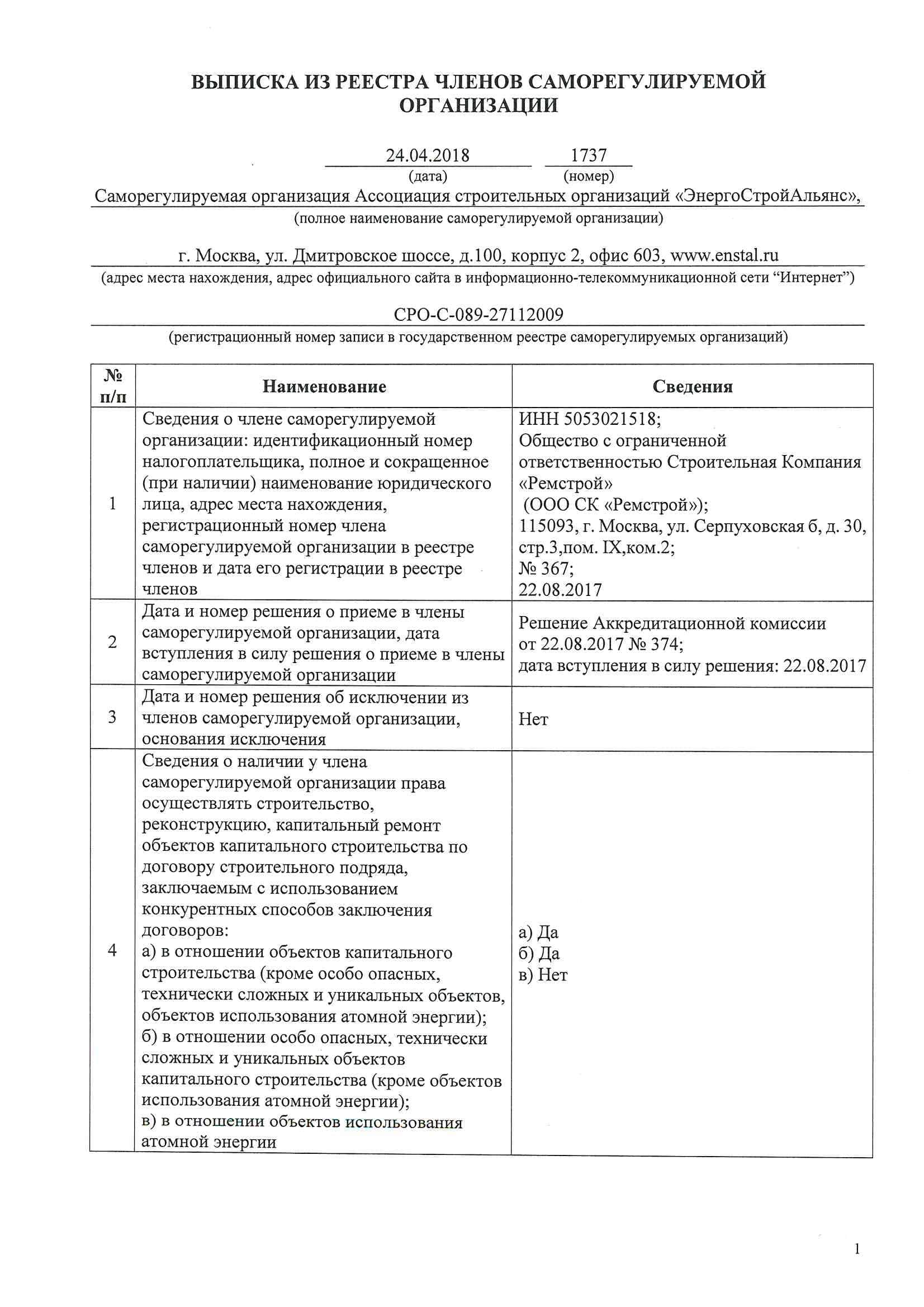
LICENSE OF MINISTRY OF EMERGENCY SITUATIONS
Certificates, system of managing quality.
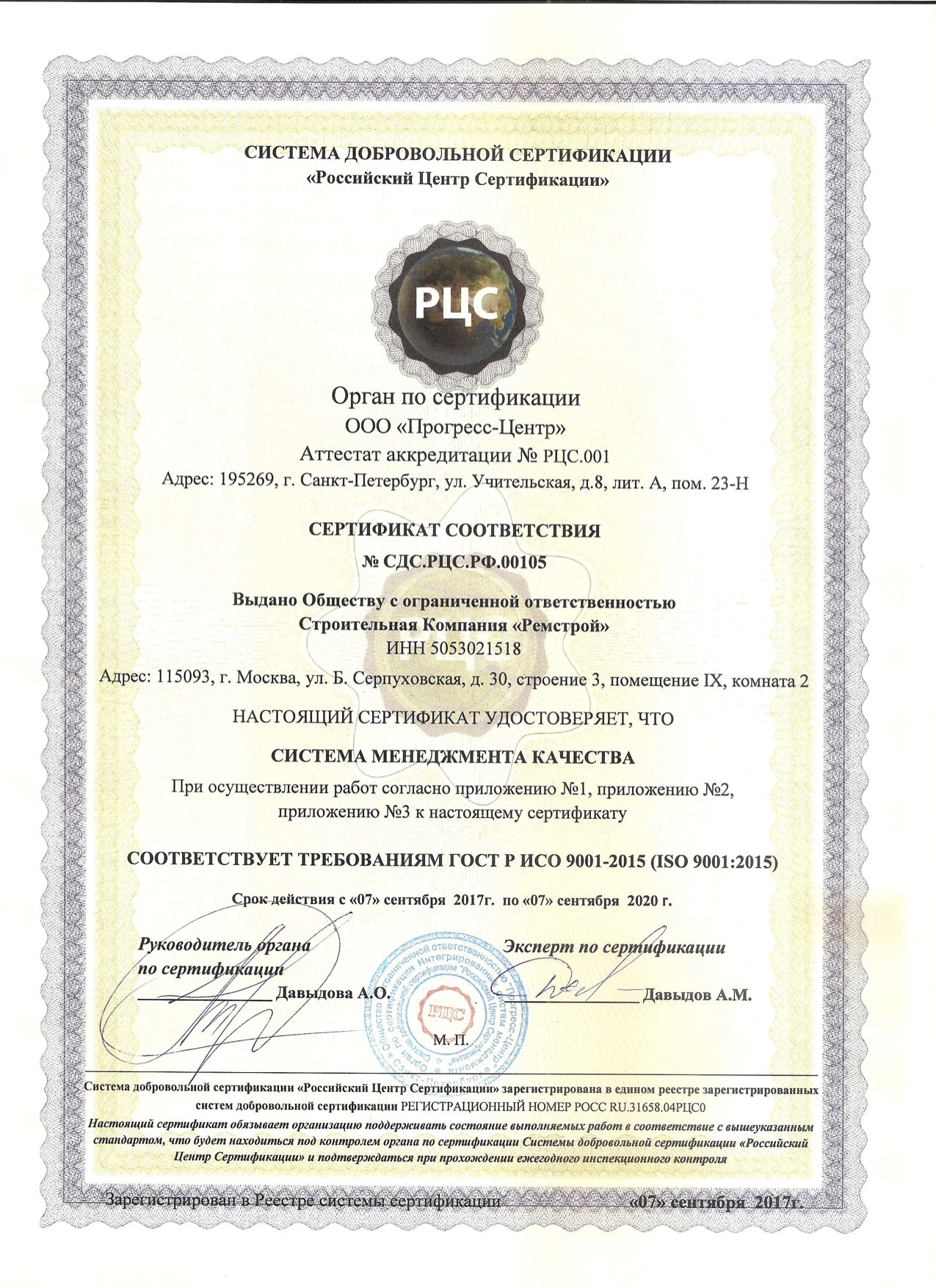
SYSTEM OF ECOLOGIAL MANAGEMENT
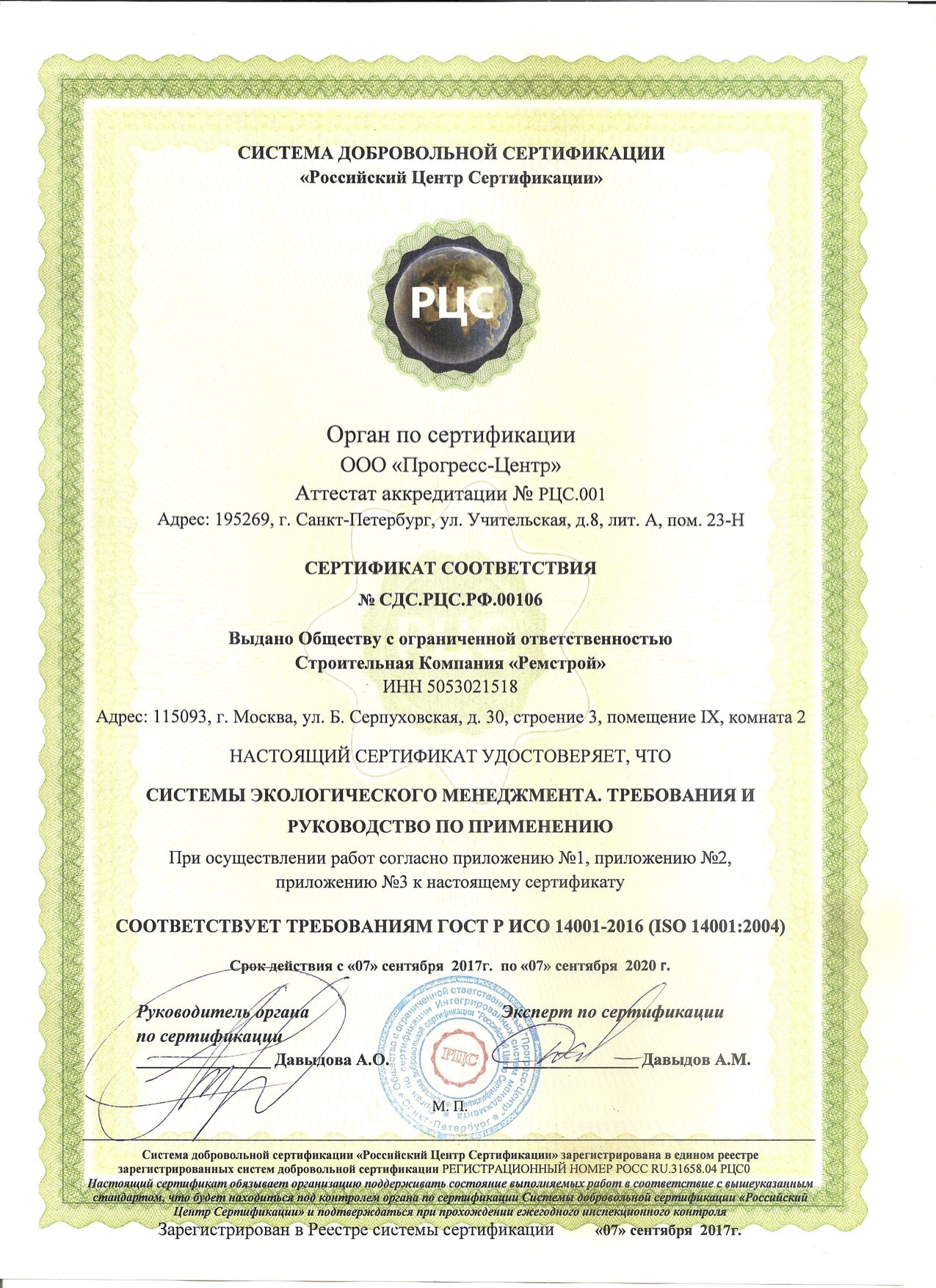
SYSTEM OF OCCUPATIONAL SAFETY AND HEALTH MANAGEMENT
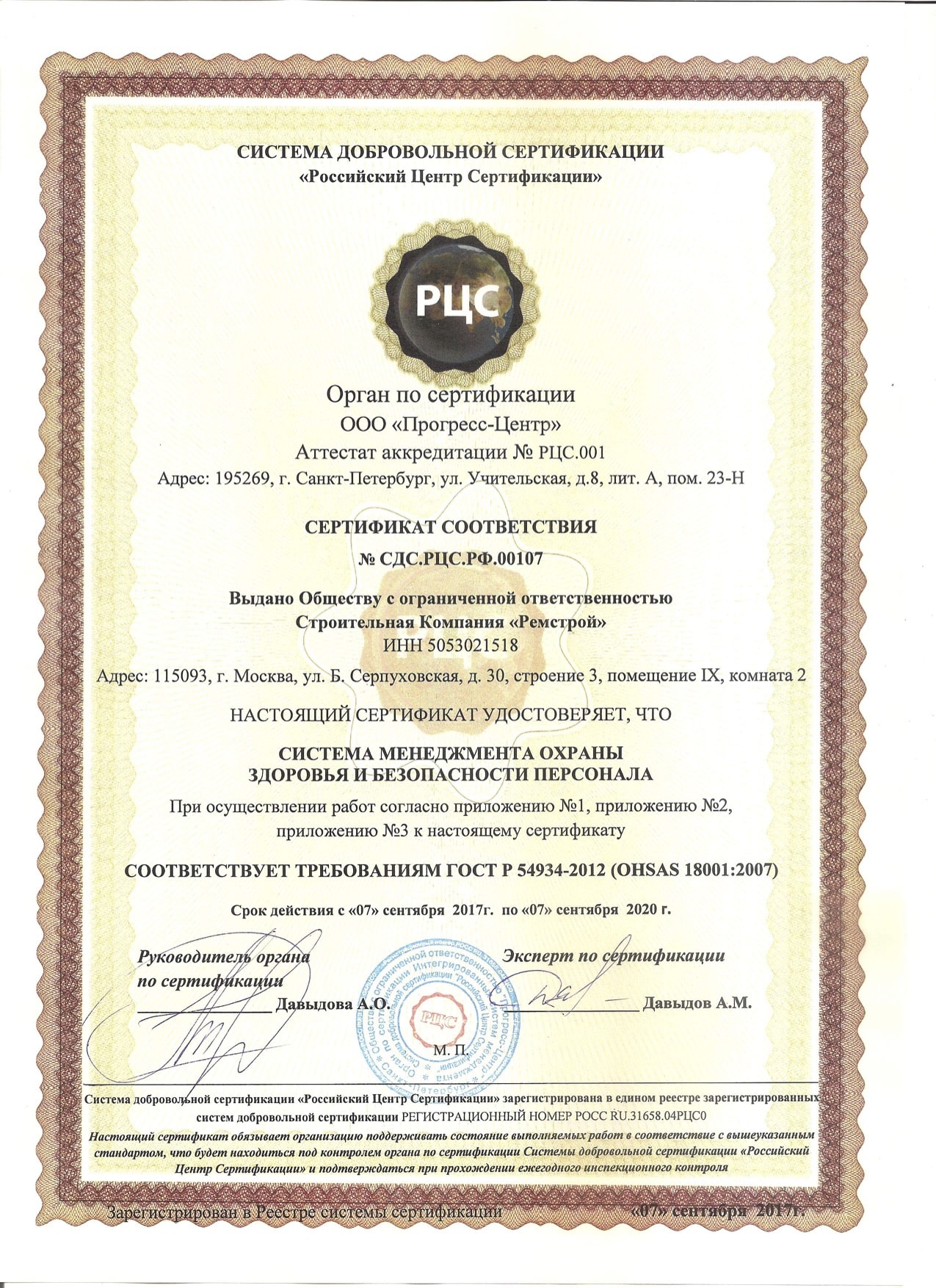
LETTERS OF RECOMMENDATION
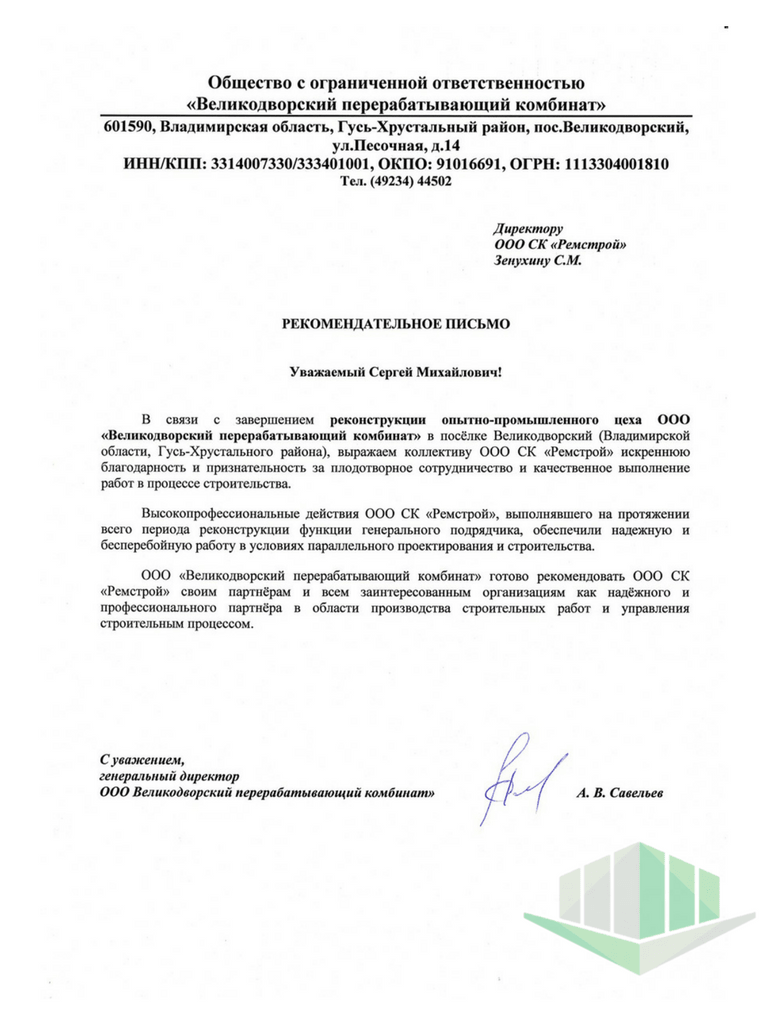
THE GEOGRAPHY OF CONSTRUCTION SITES
YOU CAN FIND MORE INFORMATION ON THE CONSTRUCTION SITES OF OOO REMSTROY ON THE PAGE OF THE SITE
OUR CLIENTS

http://remstroi.pro/yandex-promyshlennoe-stroitelstvo

Airmatic - Visit Workshop warning
- Add to quote
2003 S430 4Matic. I got the dreaded warning. based on all airmatic topics posted here, I am going to kill the easy simple route first and tackle the issue. I am trying to replace the relay and fuse but do not know the exact location, part number and where to purchase them. Anyone have information on relay location, part# and where to purchase from? Thank you.
Did you figure out what the problem was with the airmatic?
I'd like to know as well.
- ?
- 704.8K members
Top Contributors this Month

IMAGES
VIDEO
COMMENTS
The next day I got the "Airmatic-Visit Workshop" message. I searched around and the "stealer" wanted $152 for one hour plus tax and shop expenses that turns it into almost $200. So, I kindly declined and went to visit a local shop that clamied had a leveling tool. They charged half as much.
The following video will show you how to check the relay on a Mercedes-Benz W220 S-Class (S430, S500, S600, S55 AMG, and CL500, CL600). Procedures are similar for other Mercedes-Benz with air suspension, but the location of the relay and Fuse may change. In this S-Class W220, the air compressor motor /pump is protected by Fuse 32, which is a ...
The first one is AIRmatic. The second one is your PSE pump system. The AIRmatic problem is, as AtlantisVip points out, is about your suspension. The PSE pump is what controls your door locks, trunk latch, lumbar support, and rear headrest retraction. You need two things to troubleshoot these issues.
When you disconnect the battery from an old 2002ish S-Class, upon reconnecting it you will get AIRMATIC VISIT WORKSHOP and ABS errors. This is how to fix the...
The W220 AIRmatic system is a fully supporting air suspension system which provides both static and dynamic support by means of four air struts located at the wheels. ... Mercedes documentation claims that desiccant used for air drying is maintenance free. ... "AIRMATIC VISIT WORKSHOP!". The fault is stored in the ADS suspension control module ...
703 posts · Joined 2008. #5 · Dec 7, 2019. I had same issue with no RED too low panic light, just white message ( Airmatic Visit Workshop ). My resolution was replacing the Airmatic pump for about $105.. light is off now. I figured was pump when pressing the Raise car button didn't move the car up at all.
Worlds End, Solihull. Your Mercedes. S Class / 2003 / 5000cc. Feb 26, 2014. #1. Hi Gang, I have a 2003 S500 with 52,000 miles on the clock. Today on the way into work I hit a pot hole and immediately the "Airmatic - Visit Workshop" warning message was displayed (co-incidence?). I left the car alone until it was time to leave and discovered that ...
🙏Please Subscribe ️http://bit.ly/381USmE Business Queries ️[email protected] Check out our popular videos:👇👇👇 IRONHIDE REBUILD ️http ...
Home > Mercedes Benz Air Suspension Troubleshooting Guide Airmatic Visit Workshop > air suspension relay and fuse 32 on W220. ... MB Medic is independently operated and not affiliated with Mercedes-Benz, a Daimler AG company. We participate in affiliate programs, including Amazon and eBay, earning commissions from qualifying purchases via our ...
Quick question for someone to hopefully answer. My s class pre face lift has airmatic visit workshop. However it will raise to max but it will not lower. The only way to do this is to bleed the air out one of the front lines. Has this happened to anyone else? If yes what caused it...
About Press Copyright Contact us Creators Advertise Developers Terms Privacy Policy & Safety How YouTube works Test new features NFL Sunday Ticket Press Copyright ...
Airmatic Visit Workshop - Some Advice Please... I have a 2004 S500 that I bought 2 months ago with 32,800 miles. Now, after putting 1,500 miles on it, I too have been receiving the dreaded "Airmatic Visit Workshop" message. This unfortunately seems to be too common for these cars.
About the Mercedes Airmatic System. In 2000, Mercedes-Benz introduced its revolutionary air suspension system known as "Mercedes-Benz Airmatic" in the W220 S-Class series including trims such as the S430 and S550. Subsequently, this cutting-edge technology spread to other popular models from that period like GL450, E500 (W211), R350, and ...
If the error is caused by the main battery being disconnected(the one in the boot/trunk),this is how to sort it. I'm not a professional mechanic,this is just...
Starmerch Discussion starter. 31 posts · Joined 2020. #1 · Nov 29, 2020. Airmatic visit workshop message after rear struts replacement on my w220 -99 model s320, my icarsoft read c1027-016 and the car goes into limp mode... Have checked all the things people have recommended on many forum, pilot bushing, strut connection, fuses, leaks and so ...
Welcome to the 628DirtRooster website where you can find video links to Randy McCaffrey's (AKA DirtRooster) YouTube videos, community support and other resources for the Hobby Beekeepers and the official 628DirtRooster online store where you can find 628DirtRooster hats and shirts, local Mississippi honey and whole lot more!
Warhammer 40k is a franchise created by Games Workshop, detailing the far future and the grim darkness it holds. The main attraction of 40k is the miniatures, but there are also many video games, board games, books, ect. that are all connected in the 40k universe. This subreddit is for anything and everything related to Warhammer 40k.
State Housing Inspectorate of the Moscow Region Elektrostal postal code 144009. See Google profile, Hours, Phone, Website and more for this business. 2.0 Cybo Score. Review on Cybo.
8 posts · Joined 2010. #1 · Jan 14, 2011. W220 Airmatic issue "Visit Workshop". My Airmatic Visit Workshop warning came on after running through a car wash with a high pressure under-carriage sprayer. I drove the car home with no noticeable sagging of the suspension. I let the car sit for a few days, thinking that a leak would become ...
2000. Seven years of successful work have shown that combining different types of activities in the same company is not always convenient. And in the year 2000 the founders of OOO Firm ERG decided to create and register a monoprofile construction company OOO Remstroy Construction Company. Industrial construction was chosen as the priority area.
Airmatic - Visit Workshop warning. 2003 S430 4Matic. I got the dreaded warning. based on all airmatic topics posted here, I am going to kill the easy simple route first and tackle the issue. I am trying to replace the relay and fuse but do not know the exact location, part number and where to purchase them.